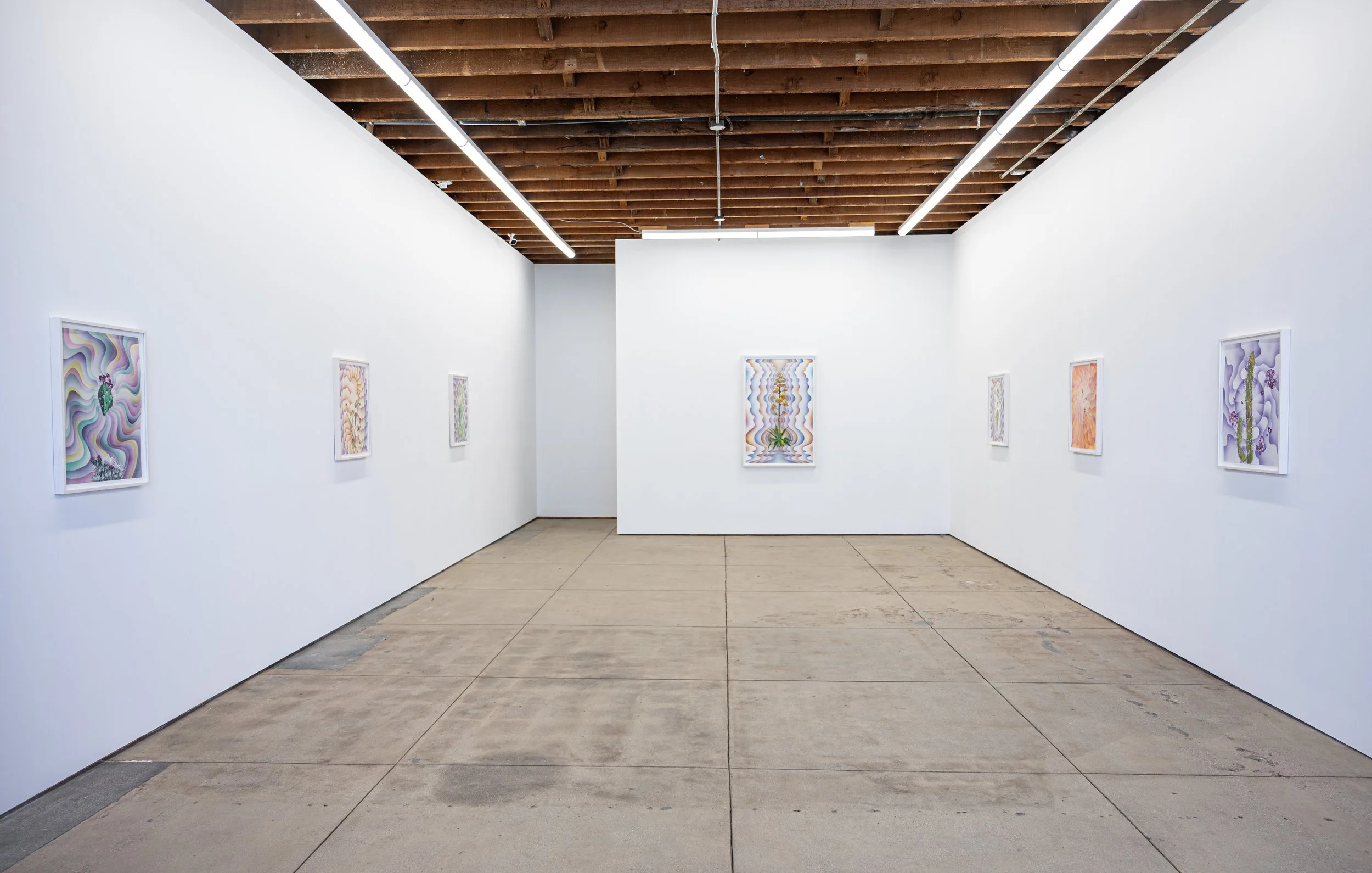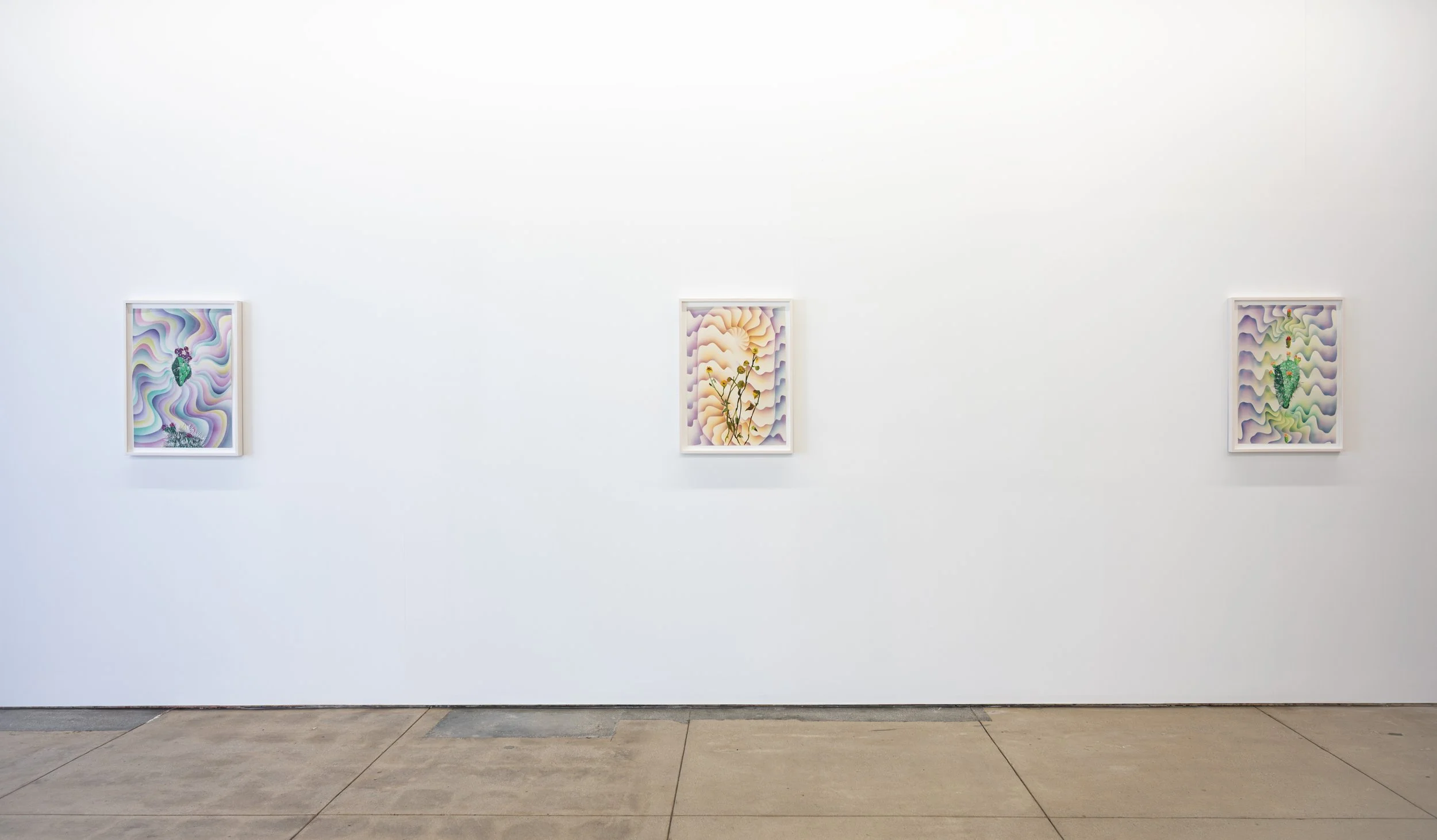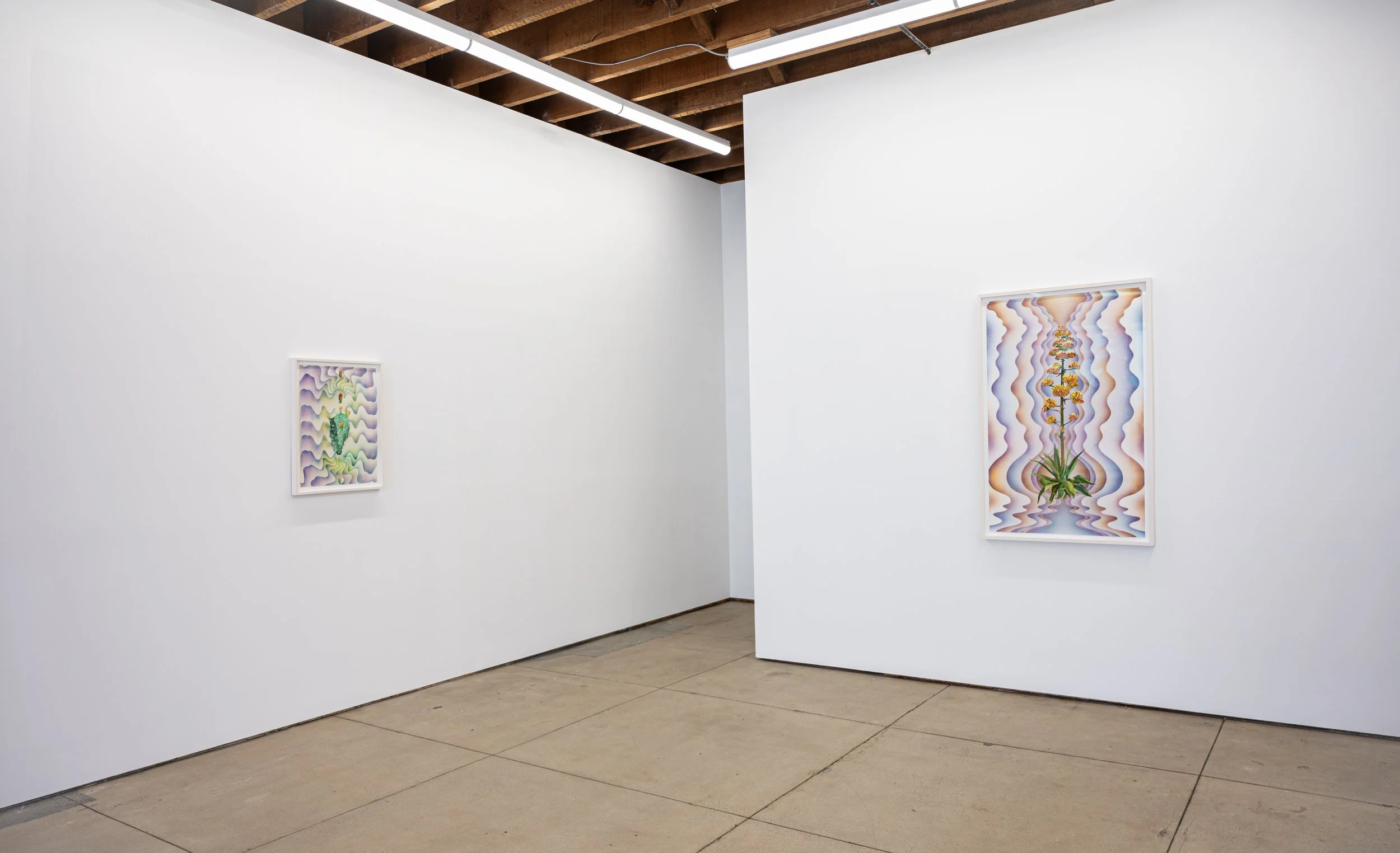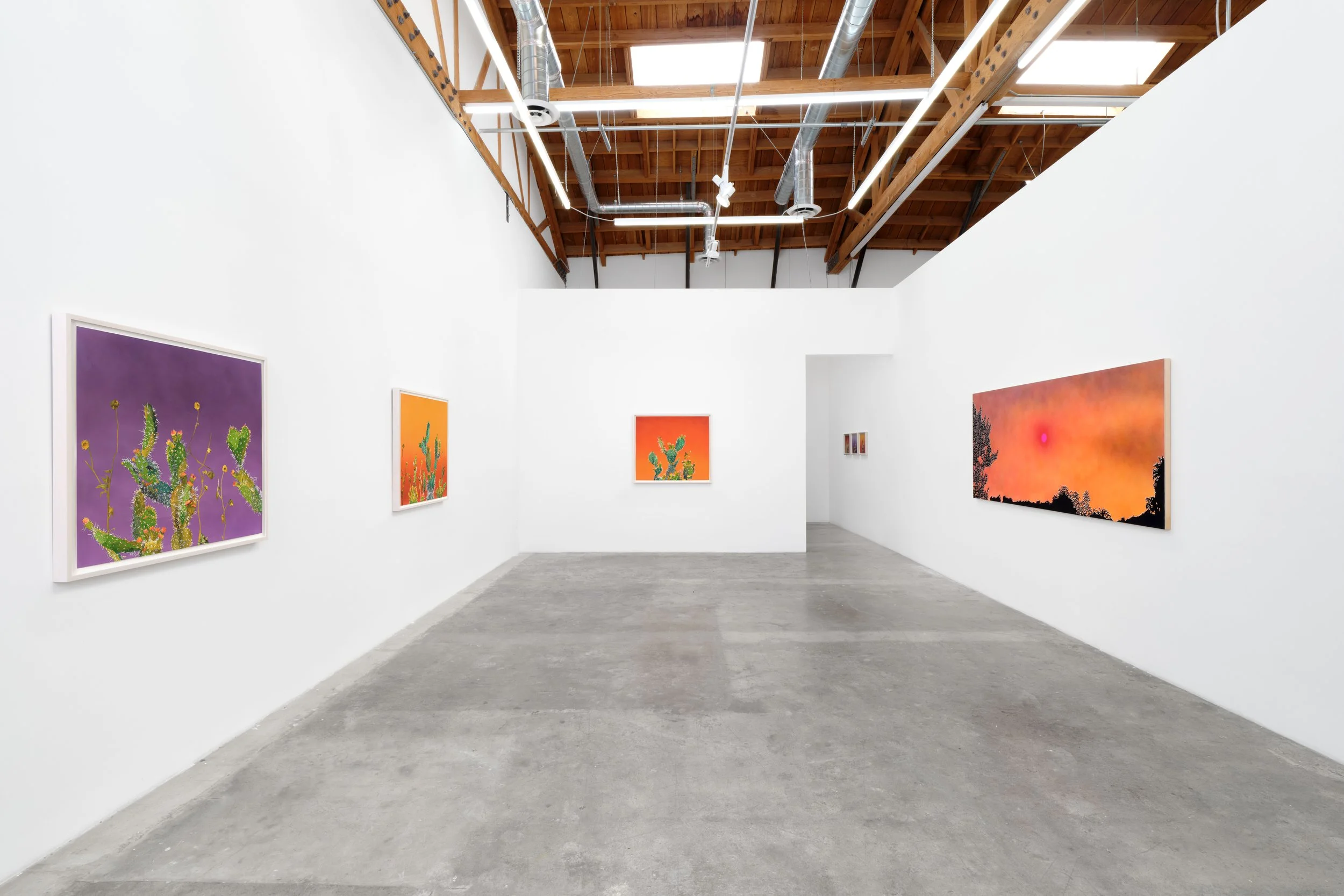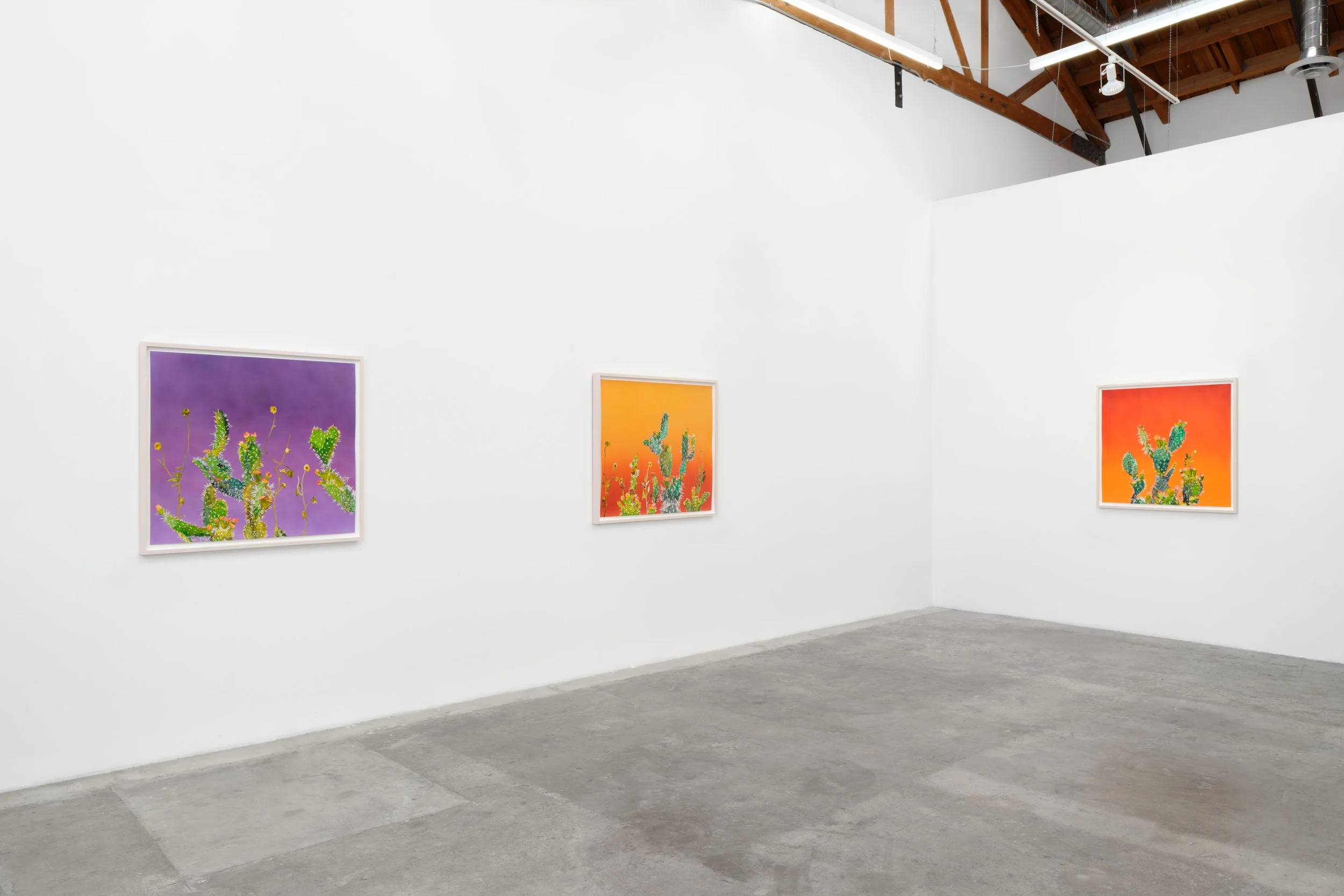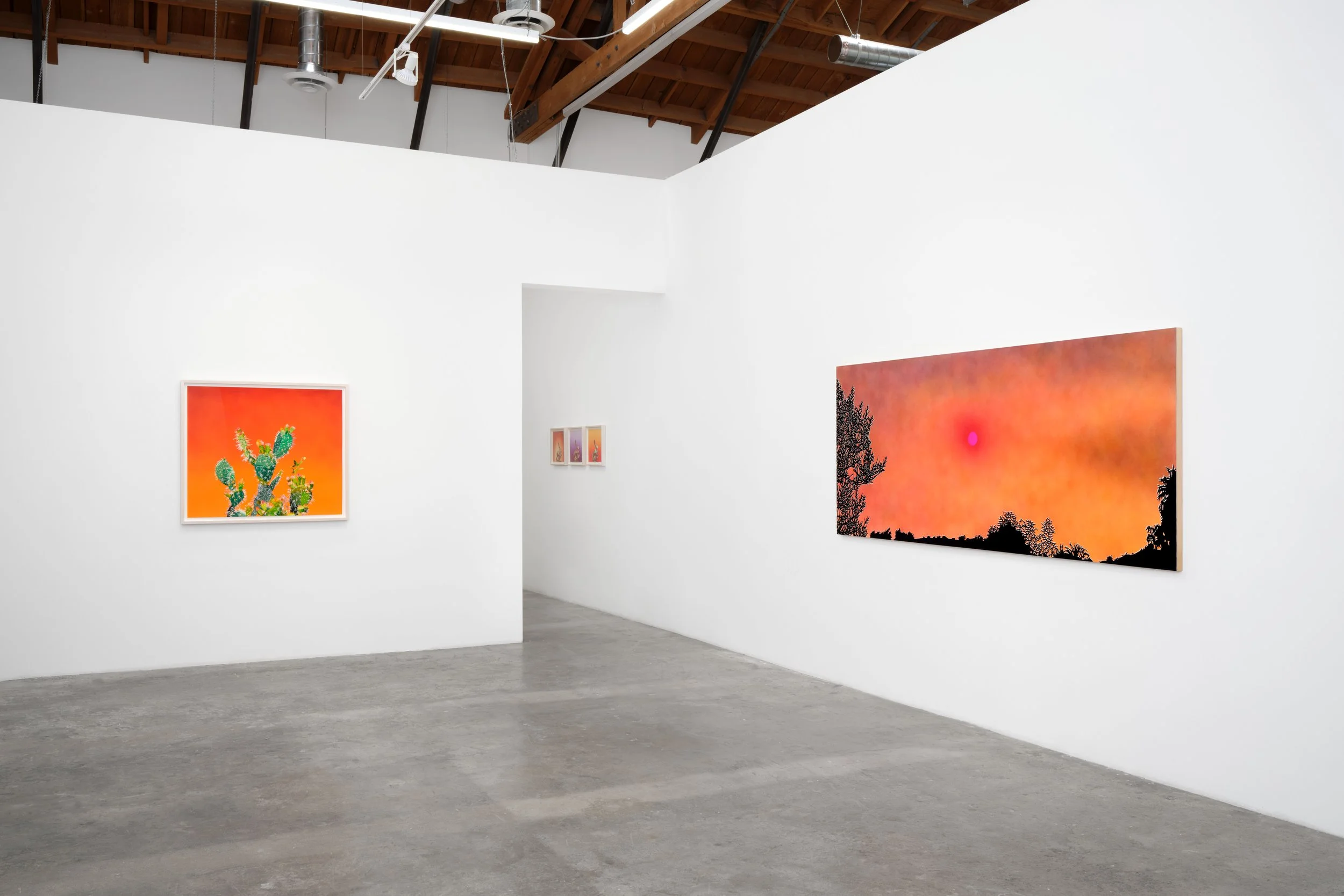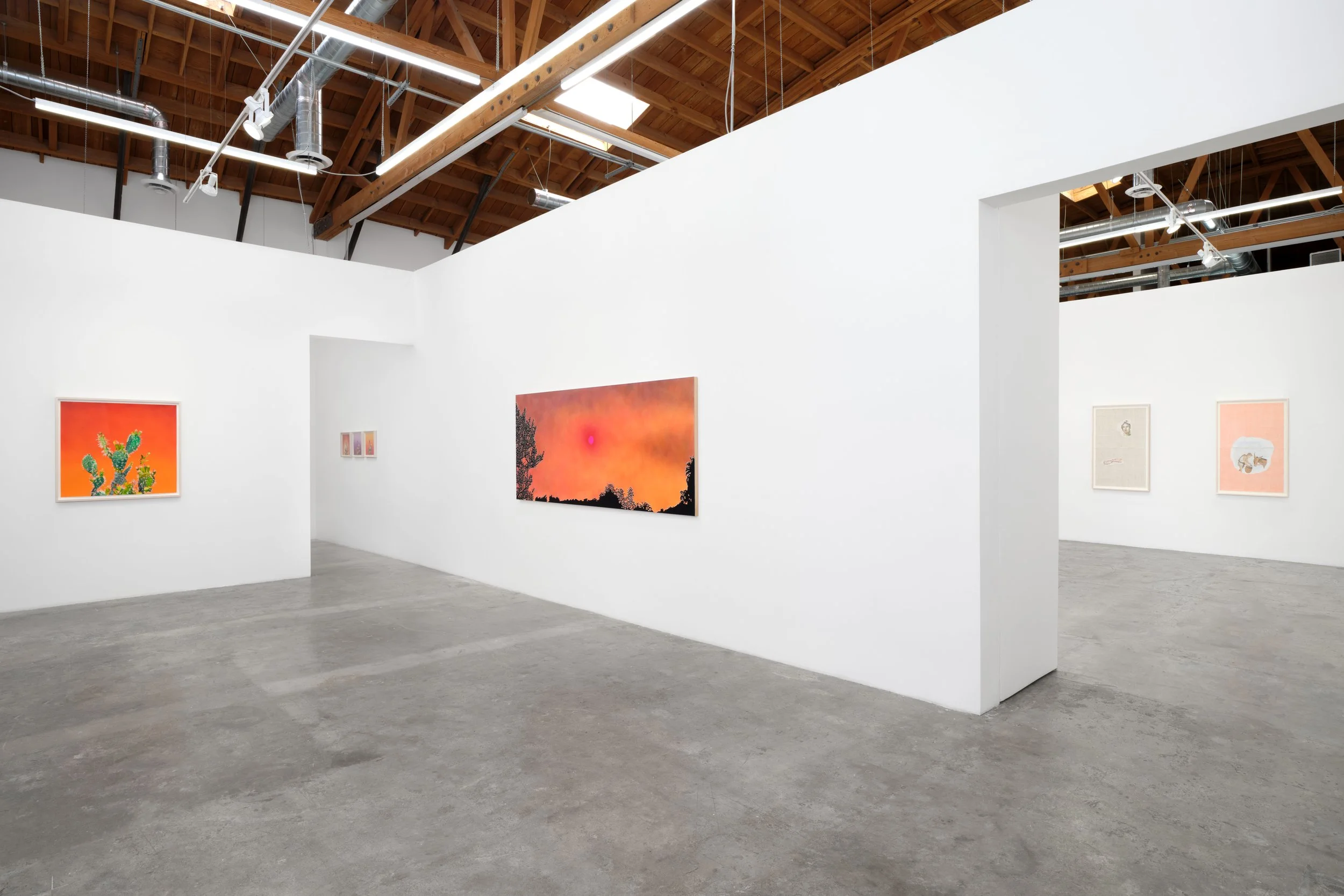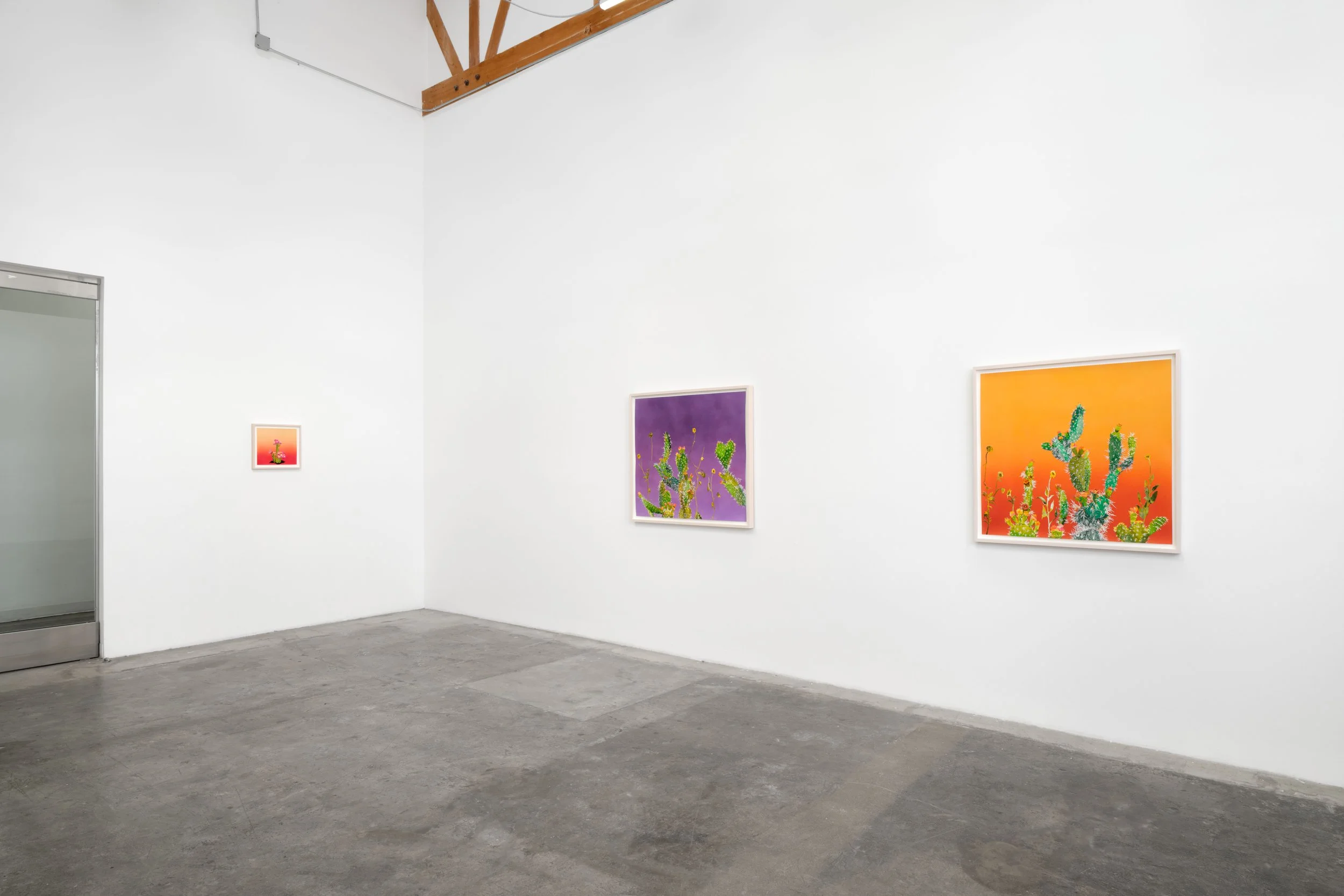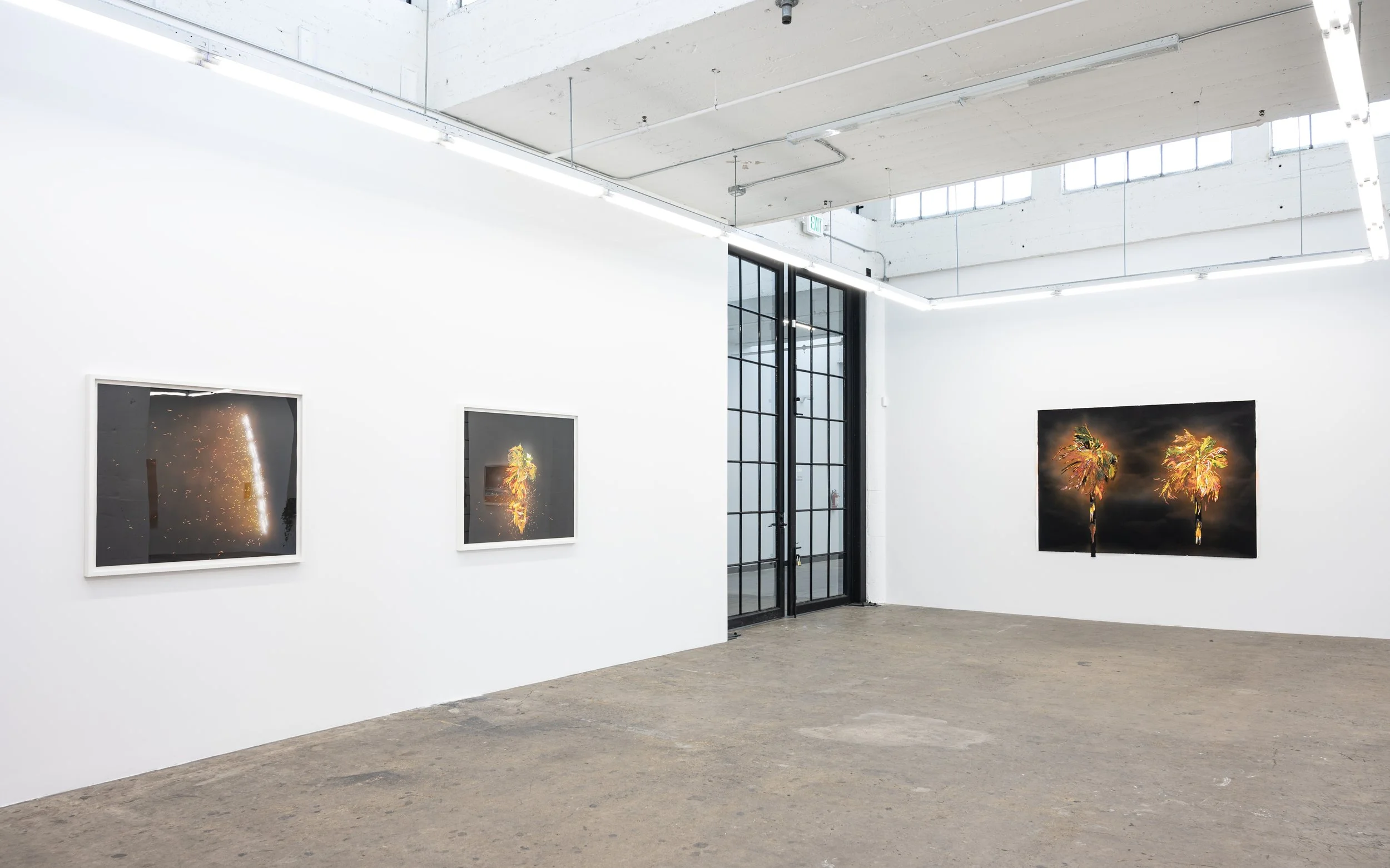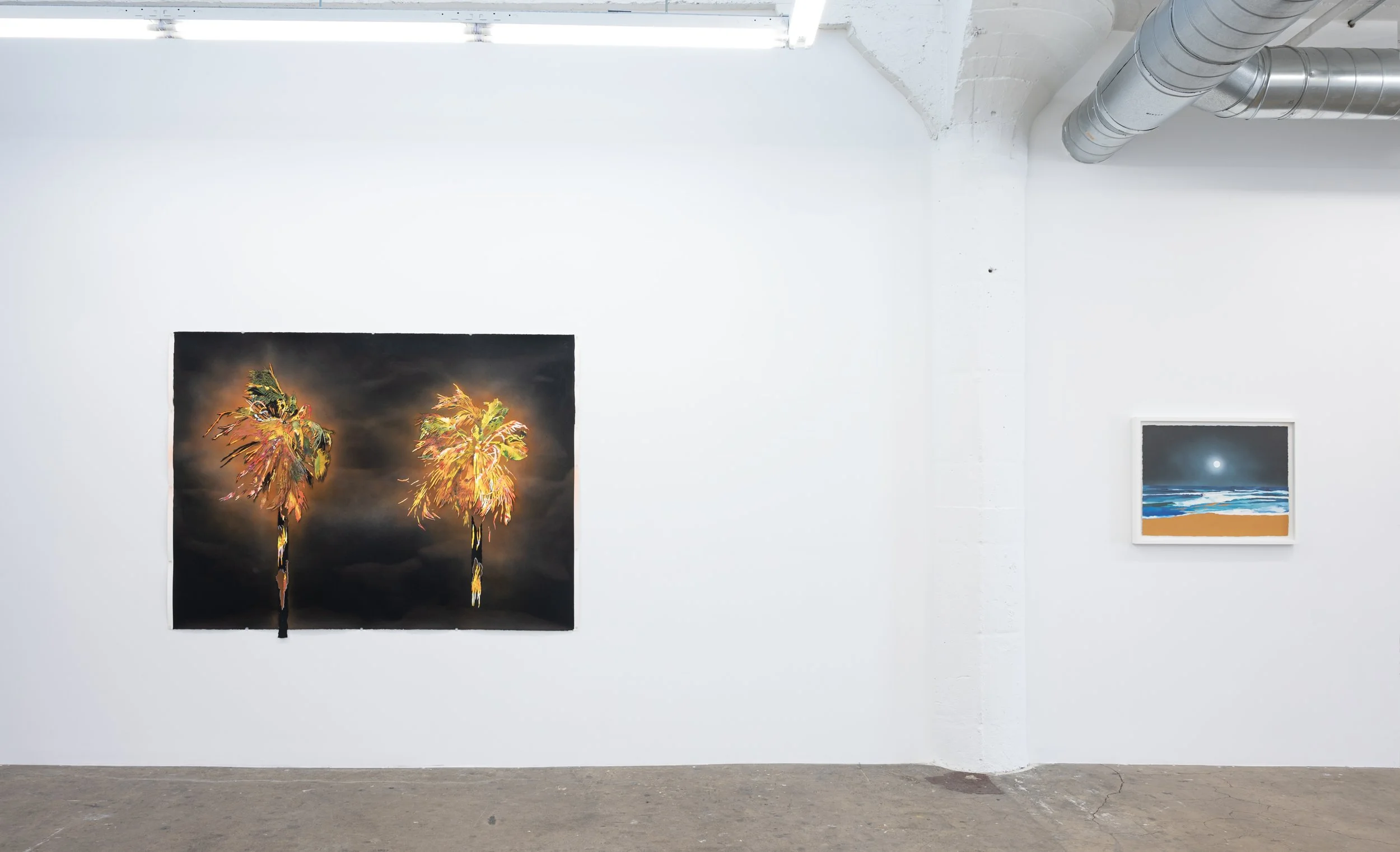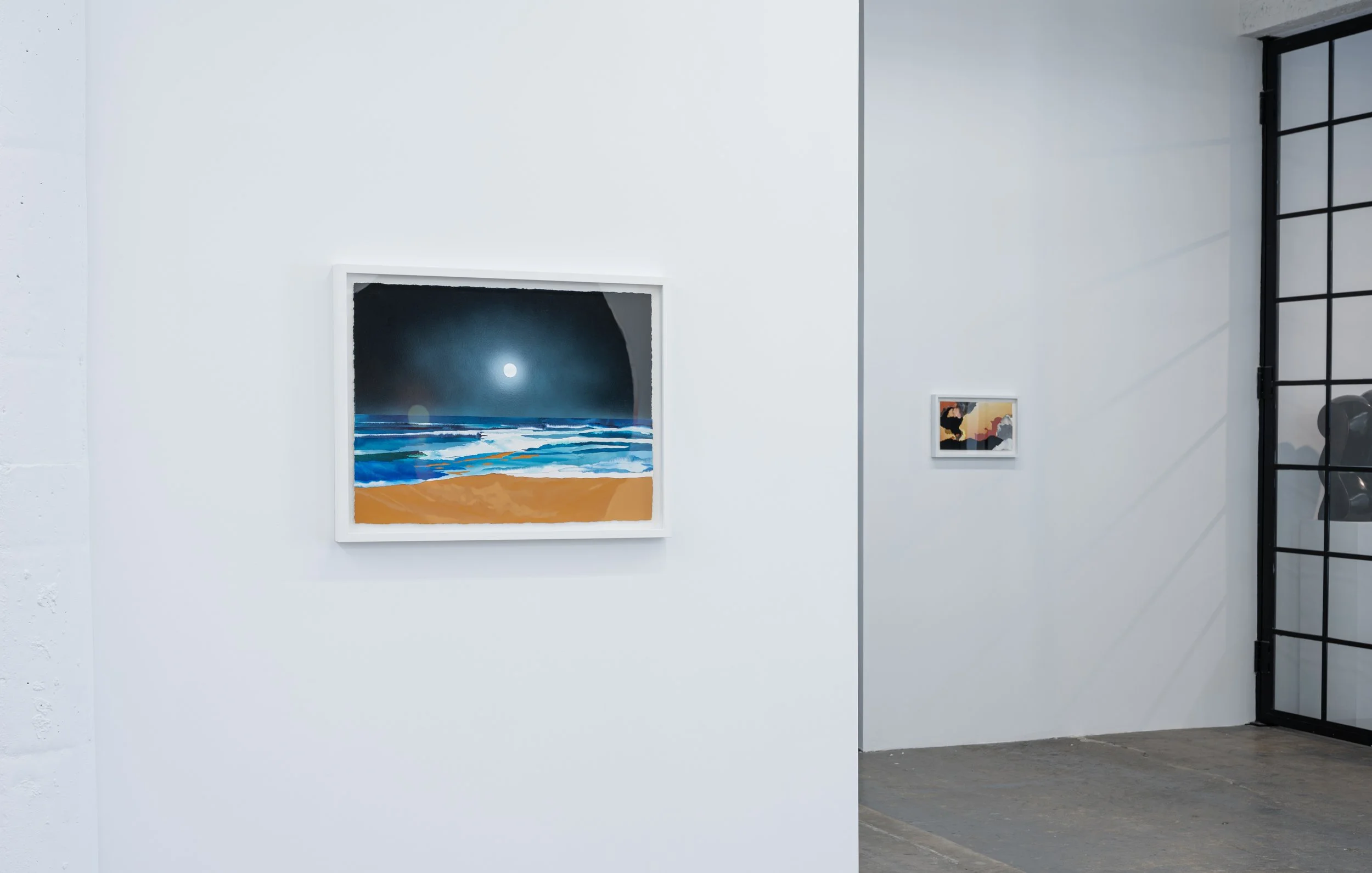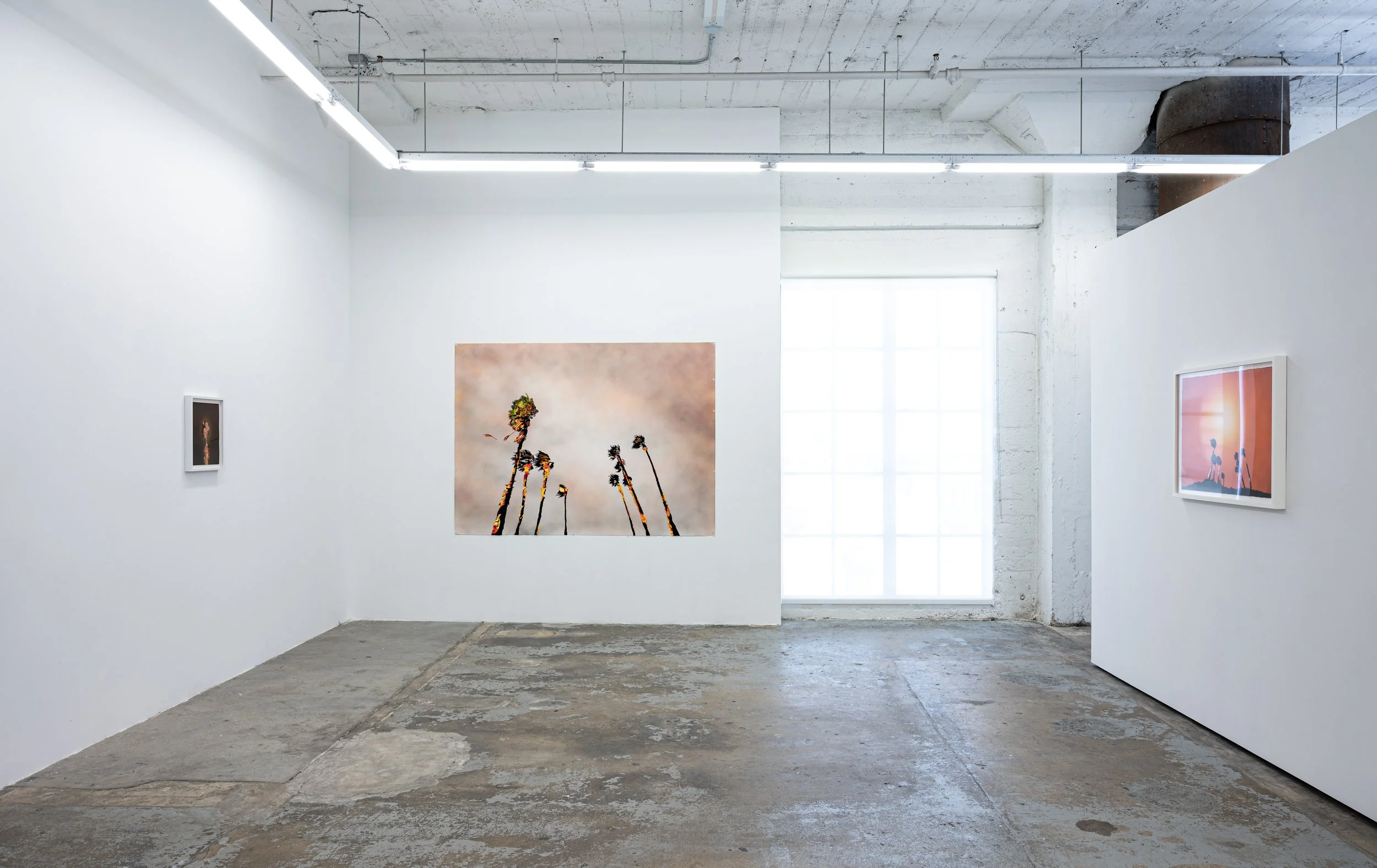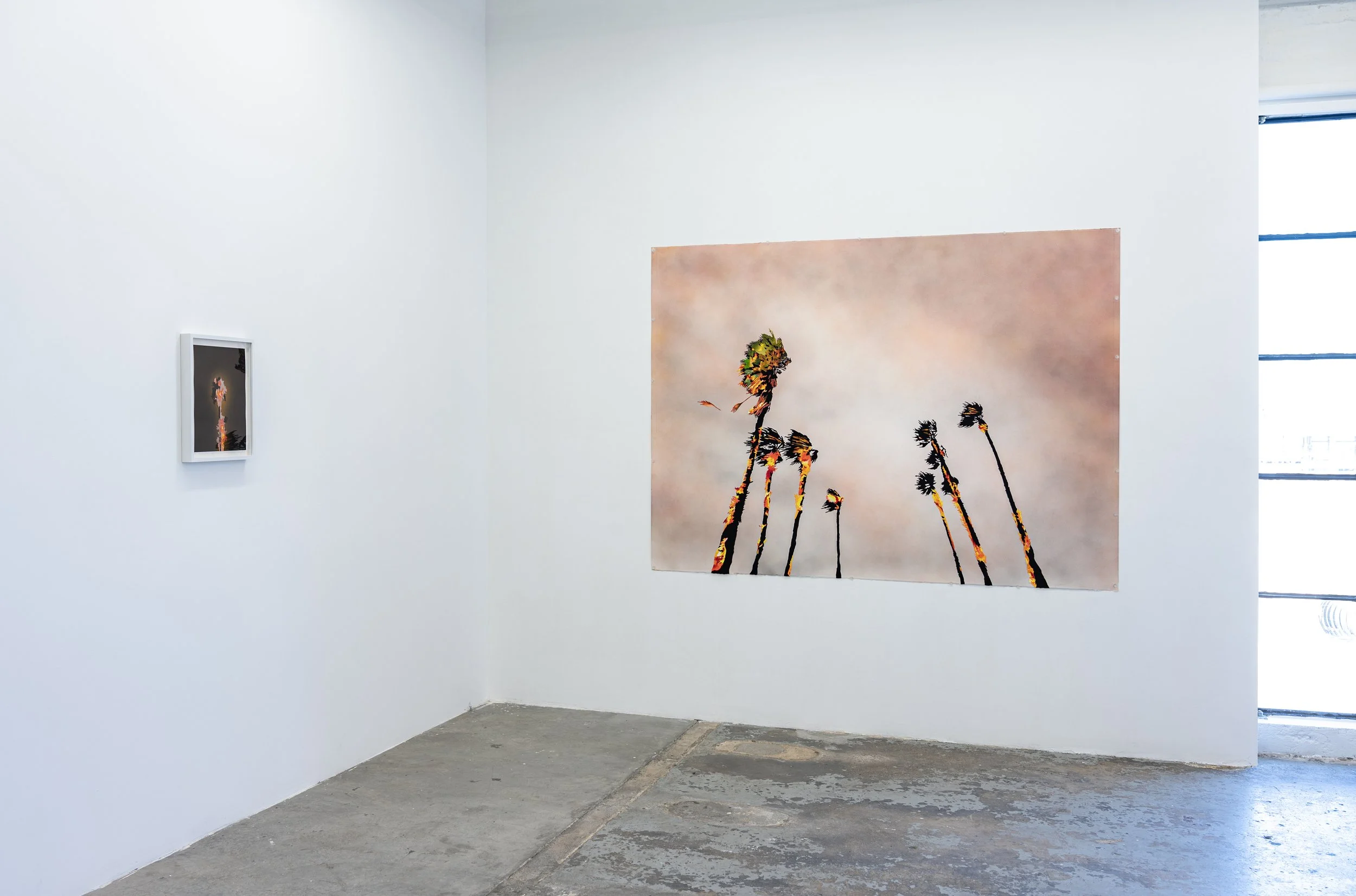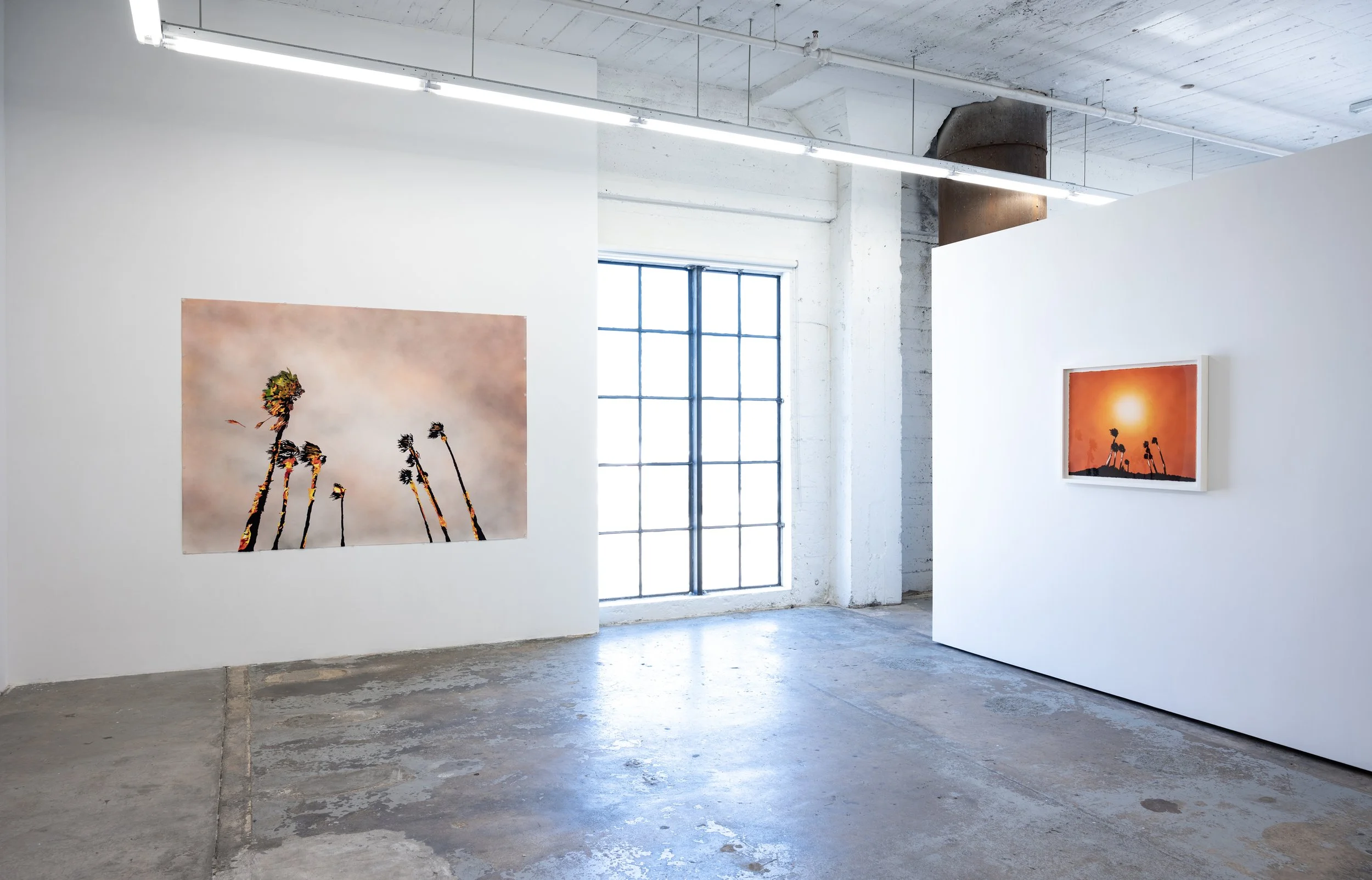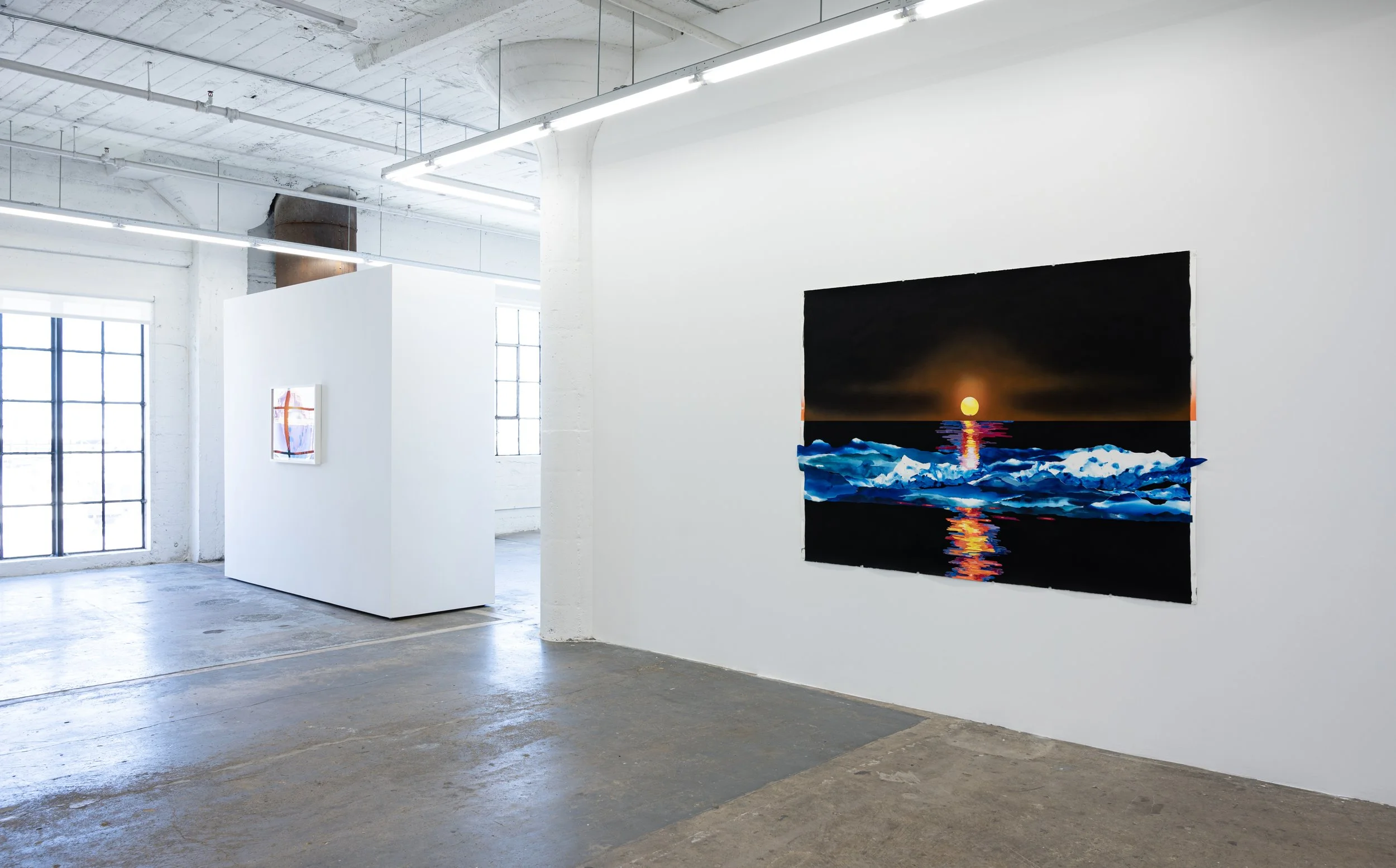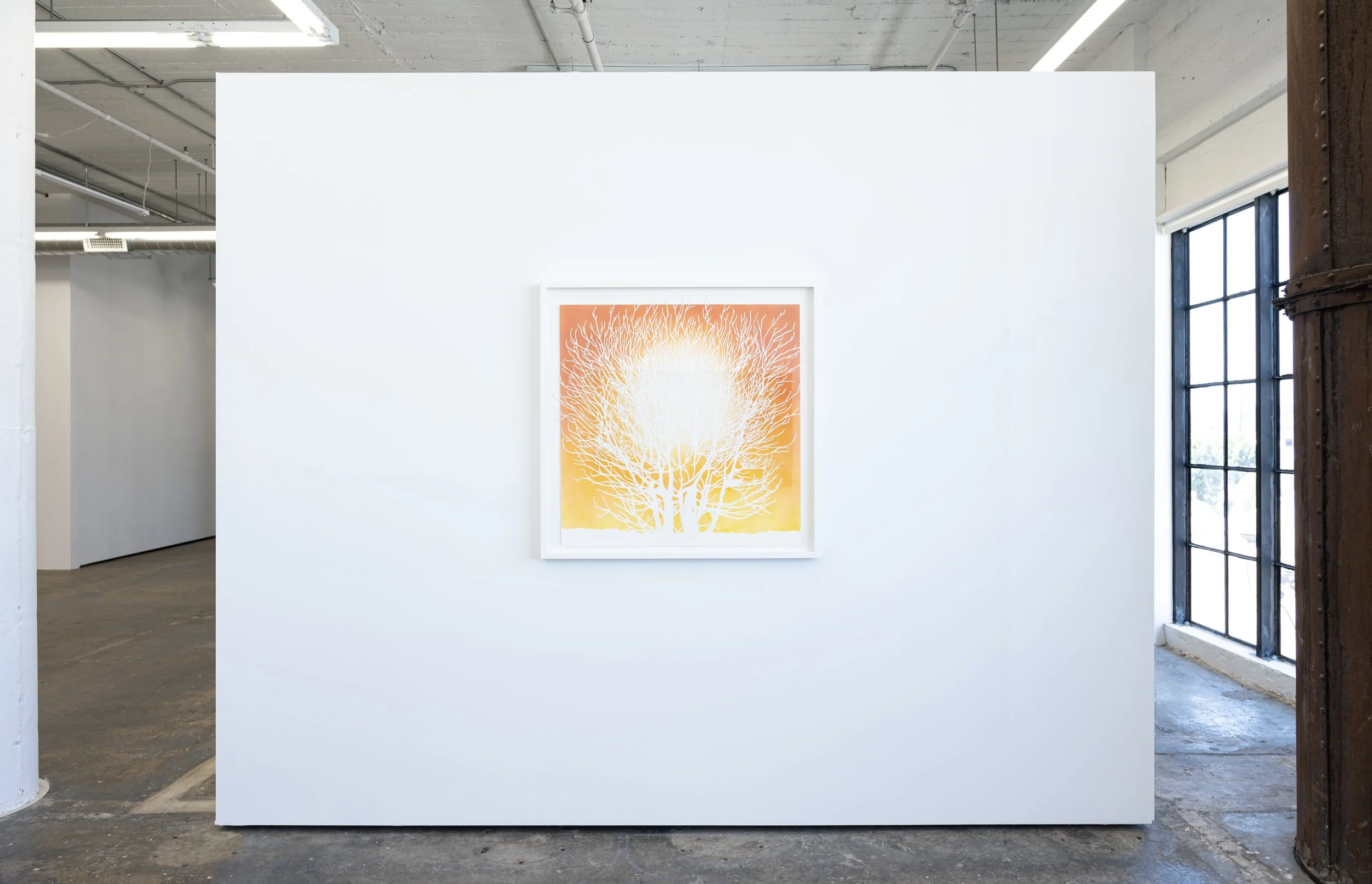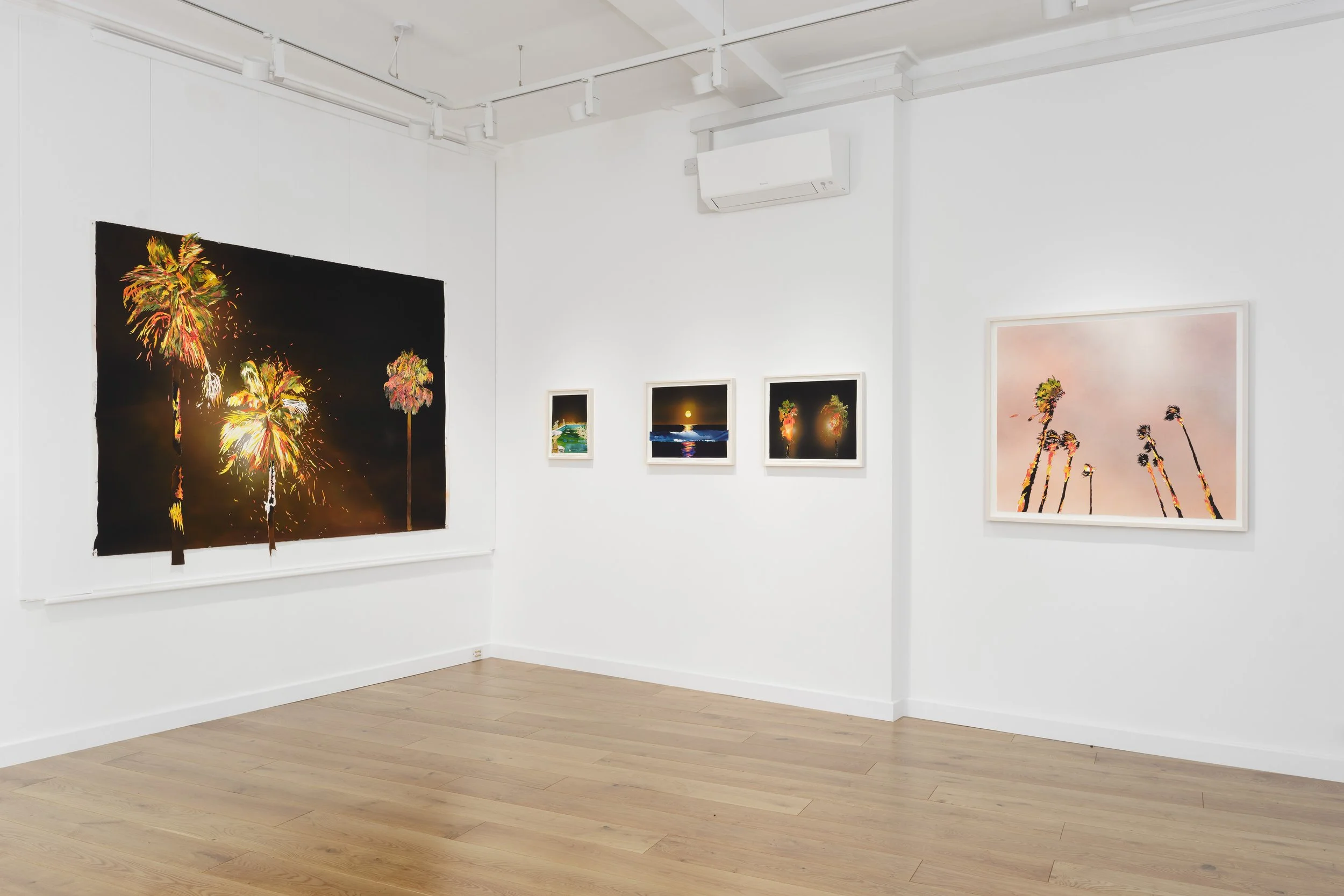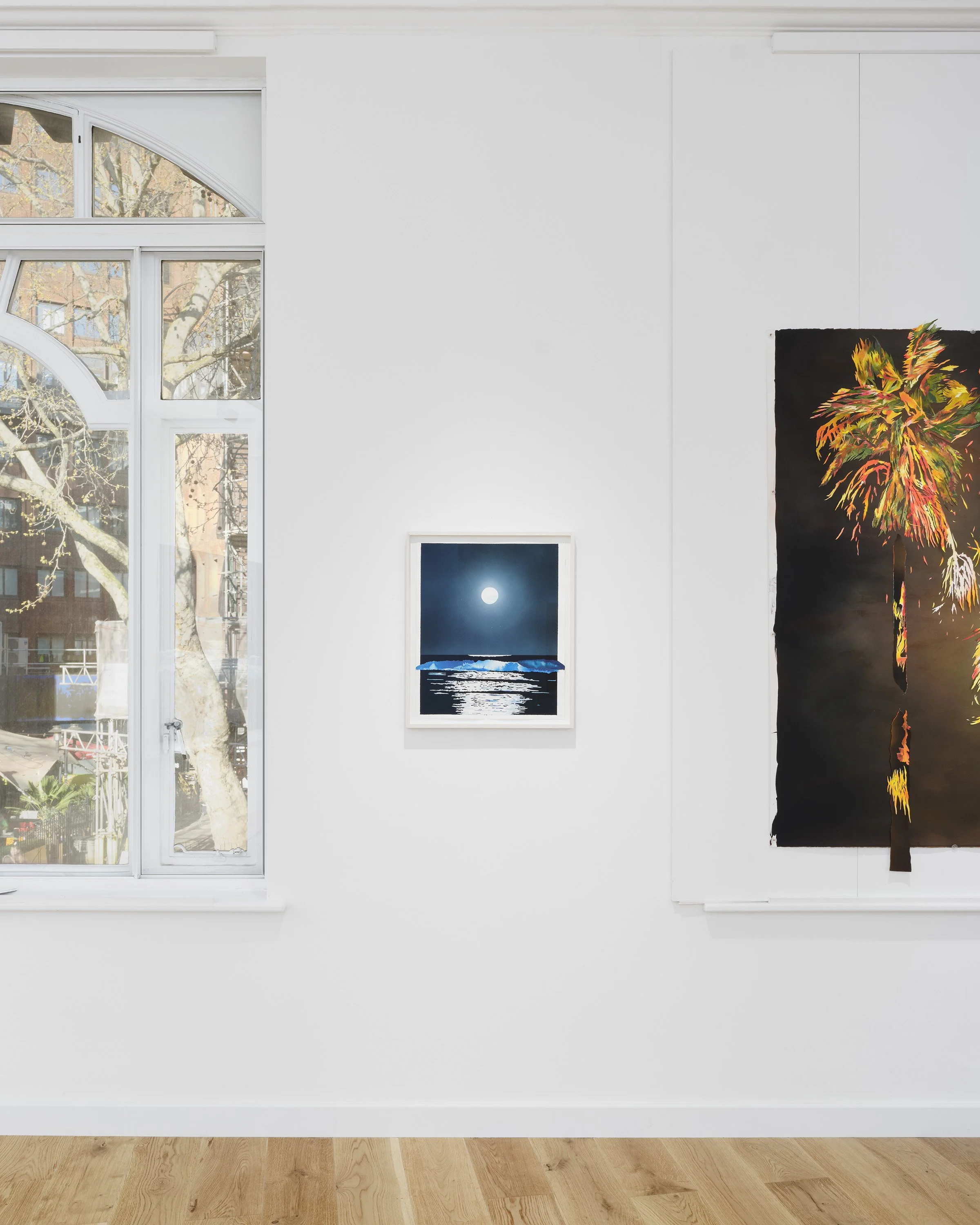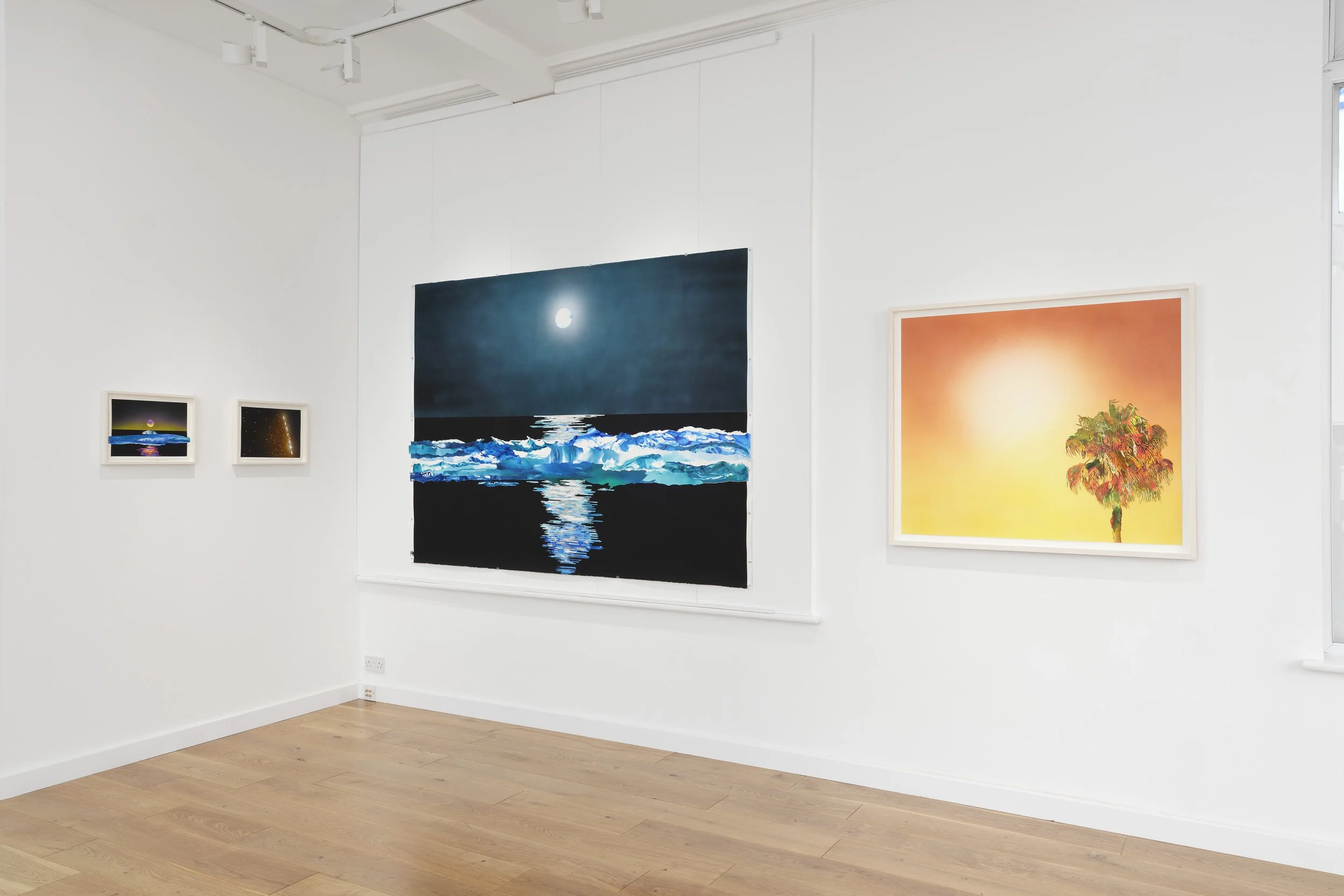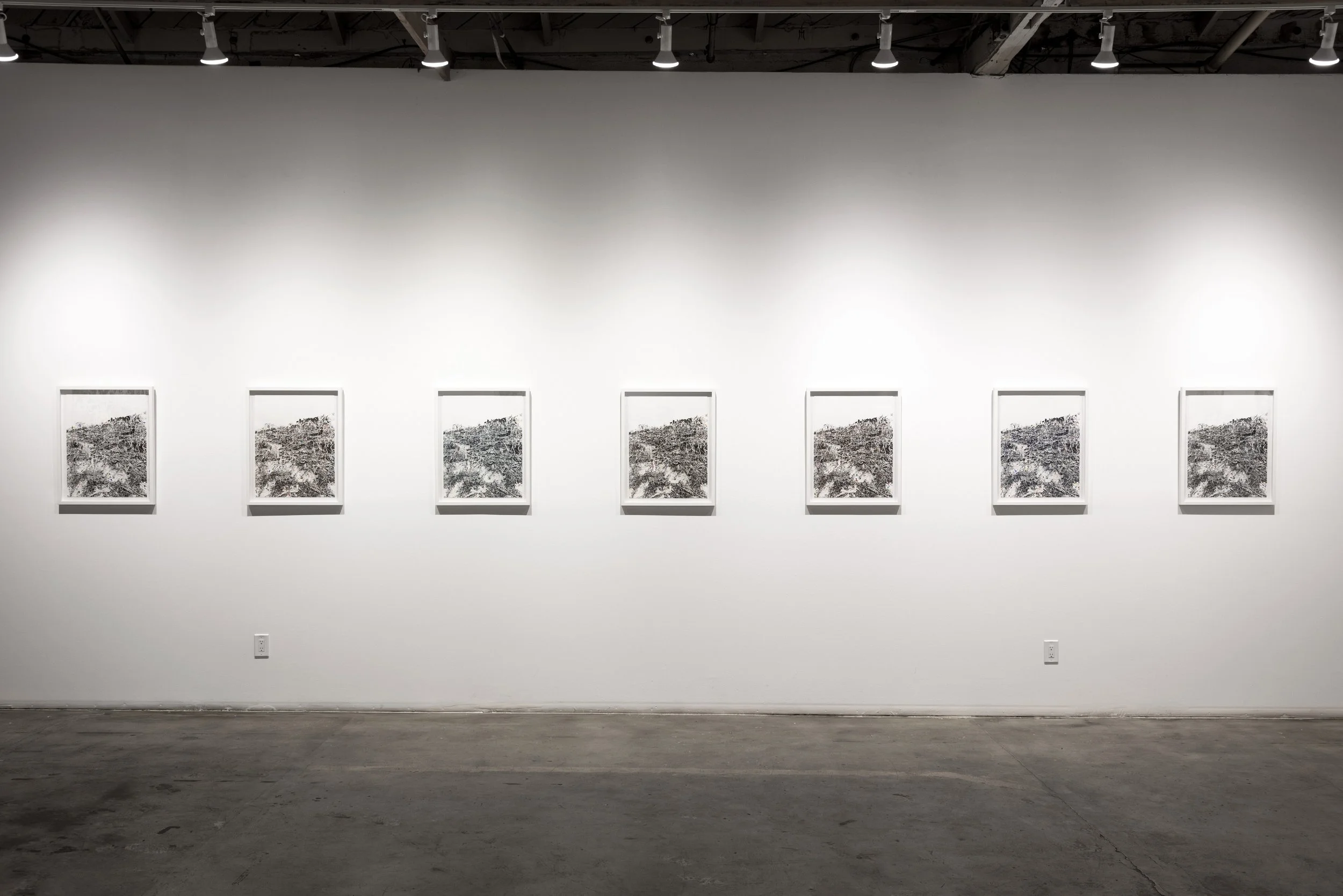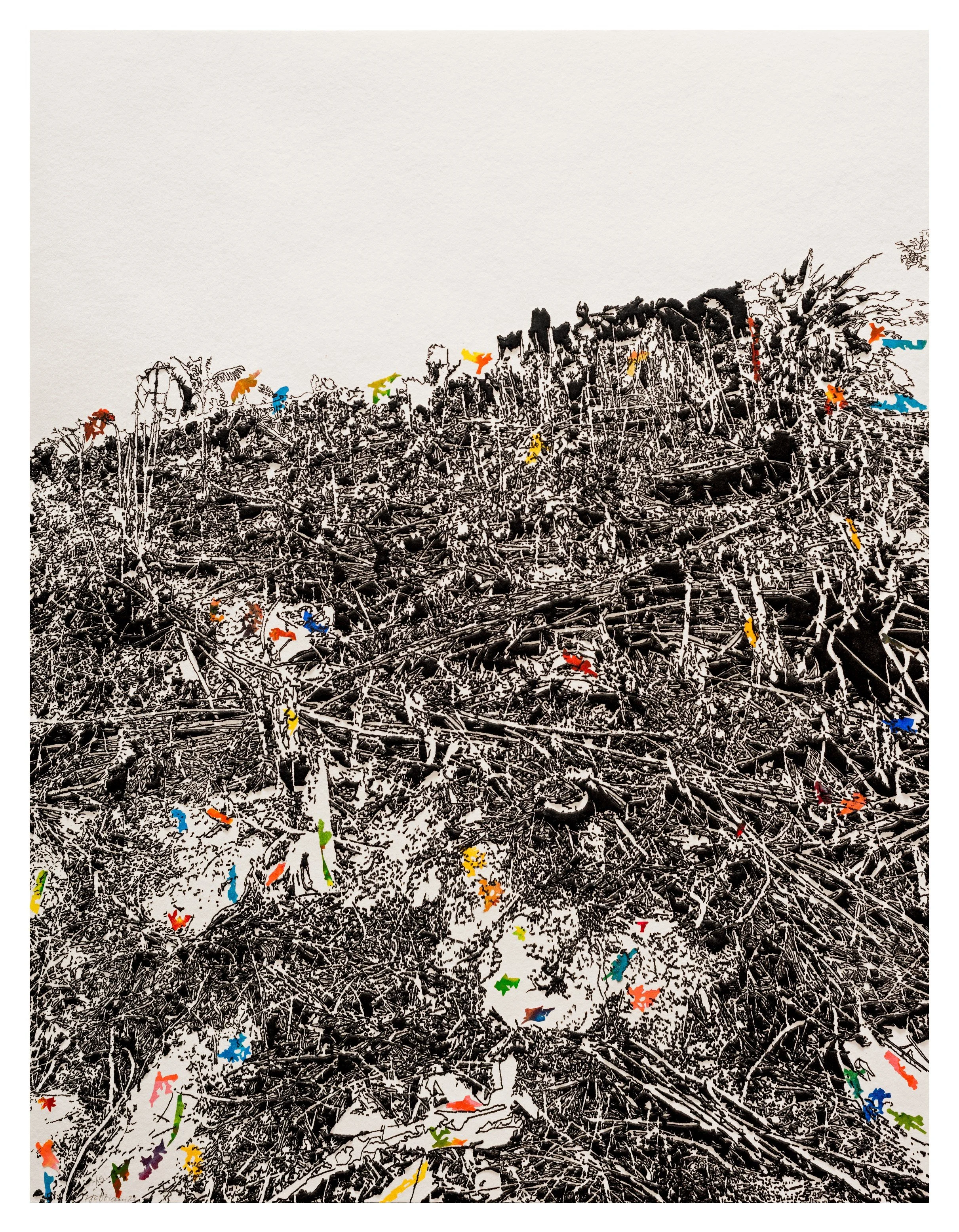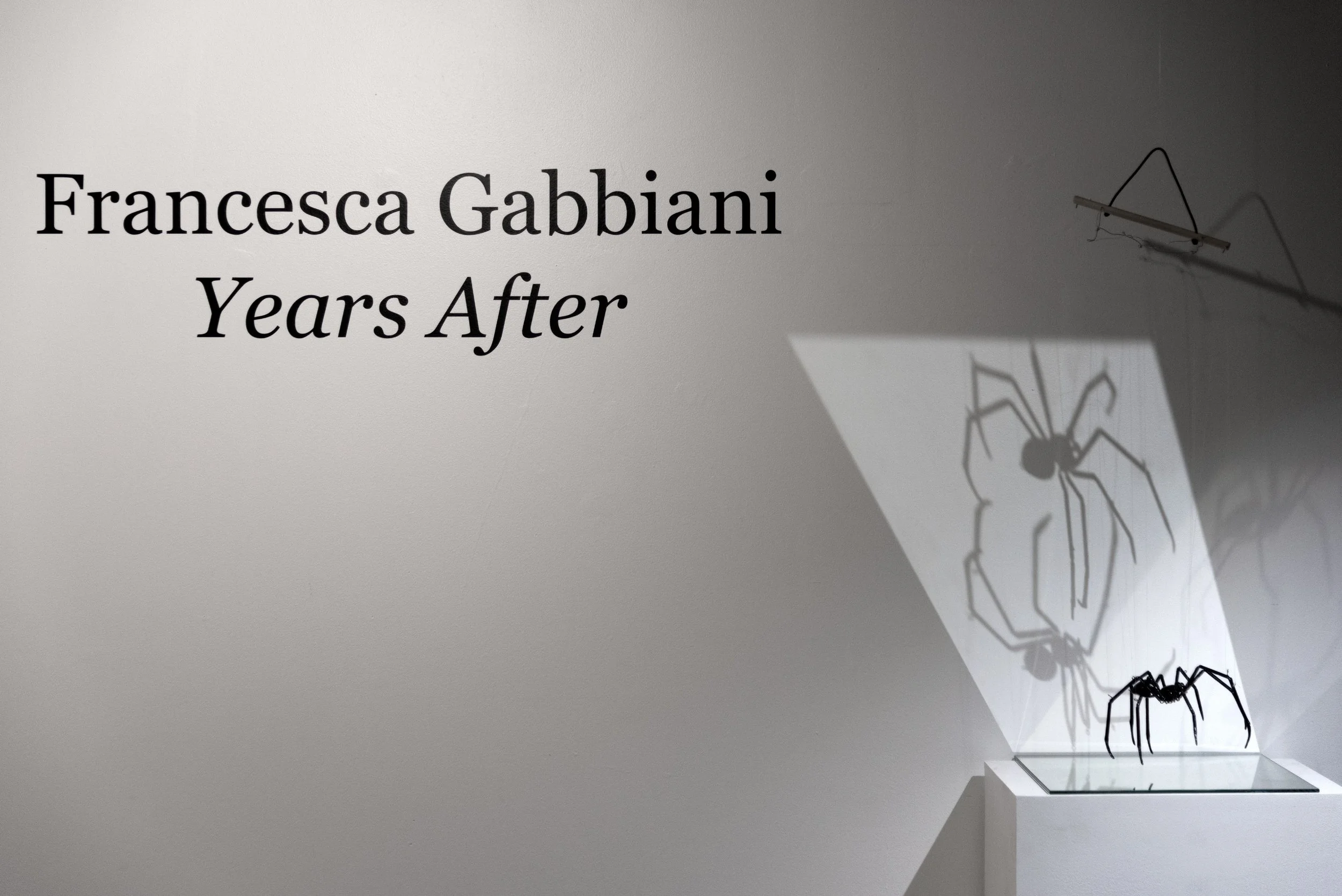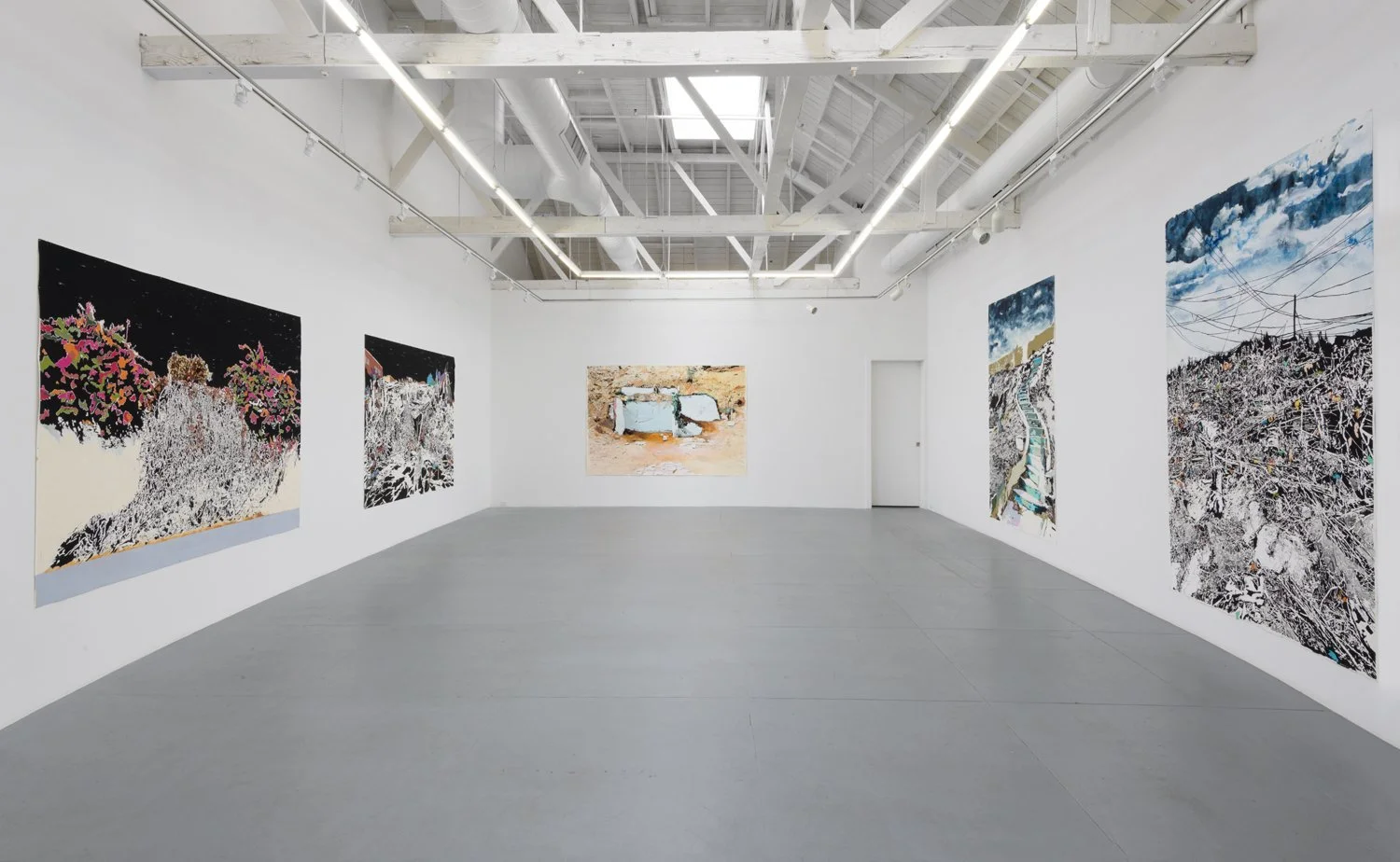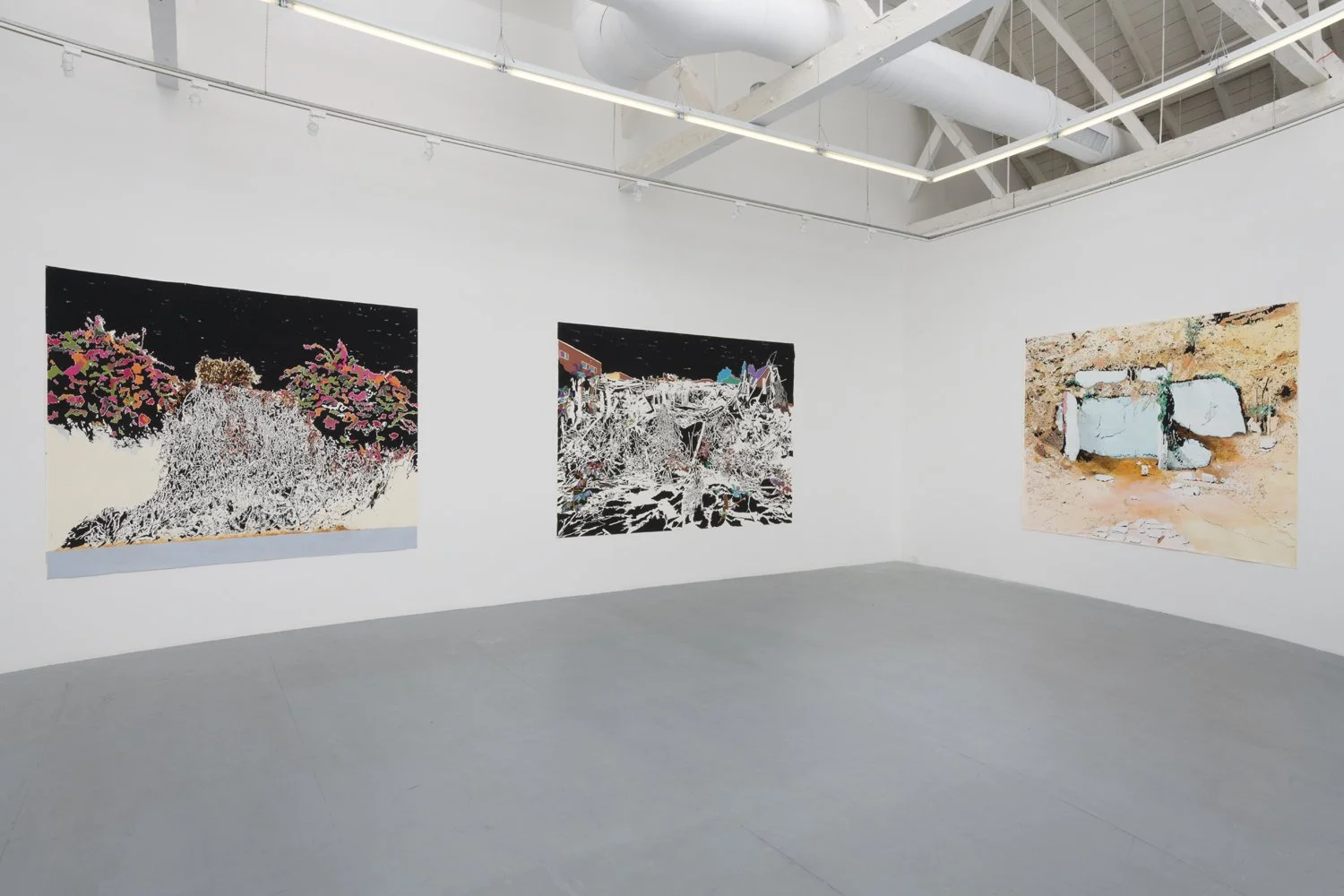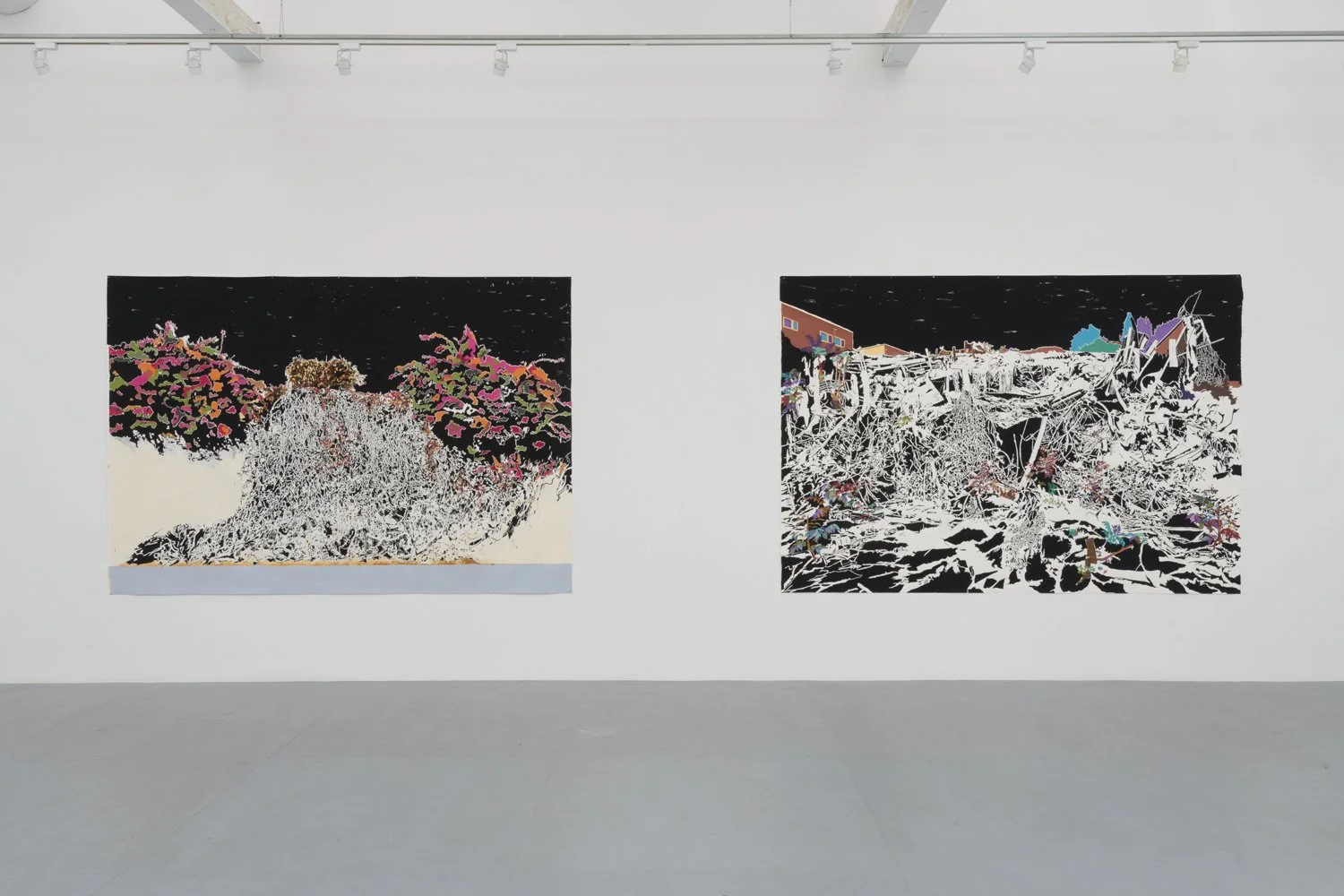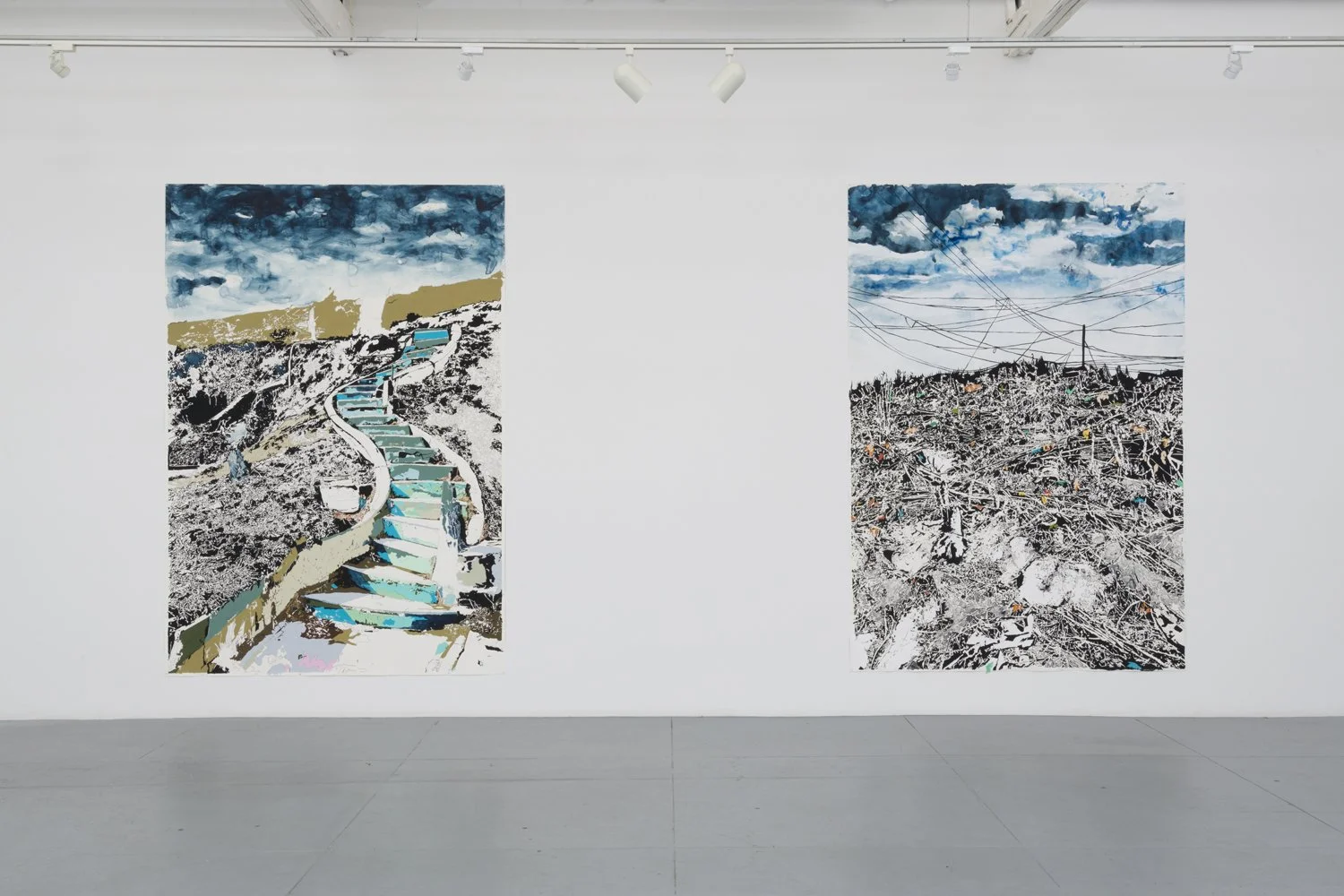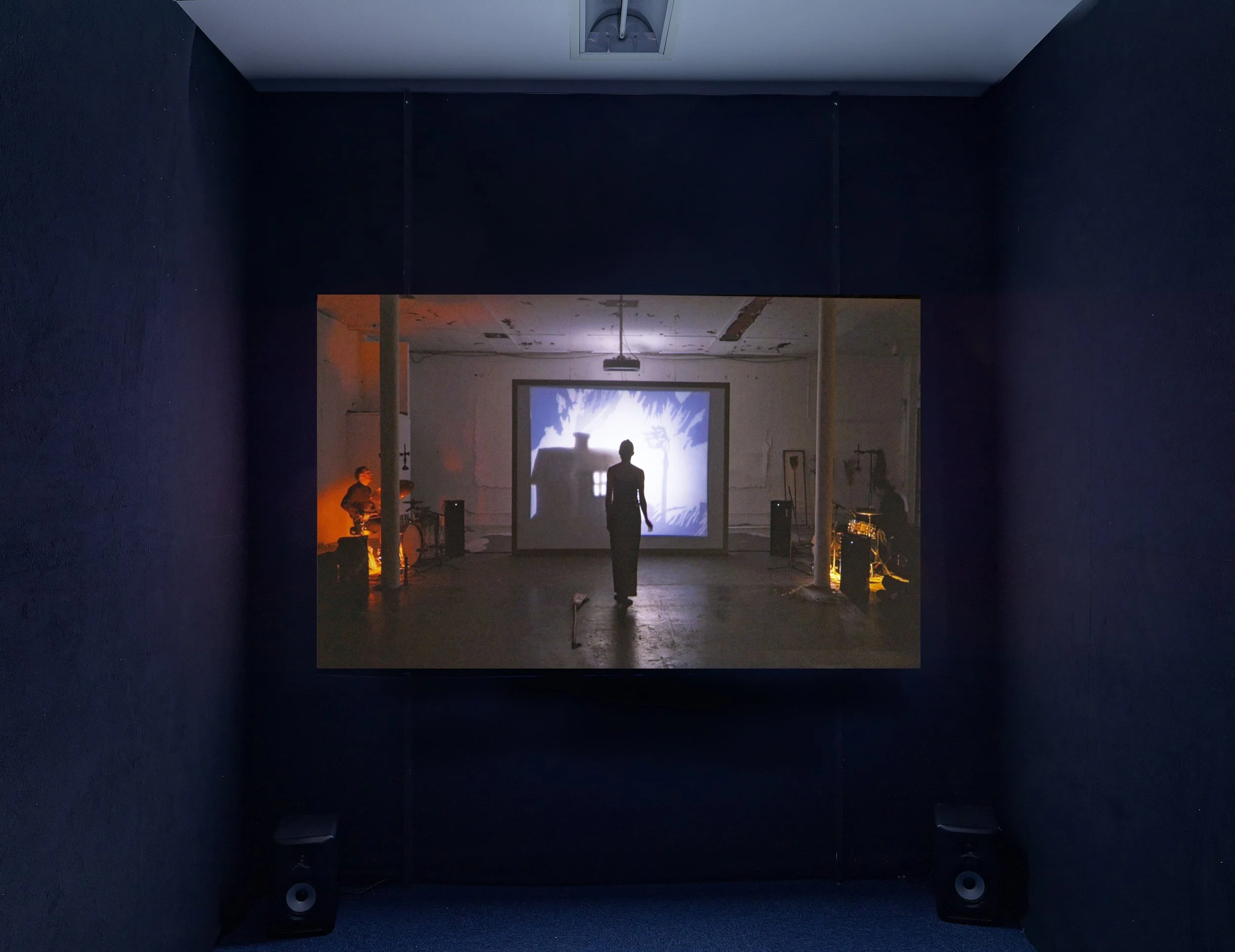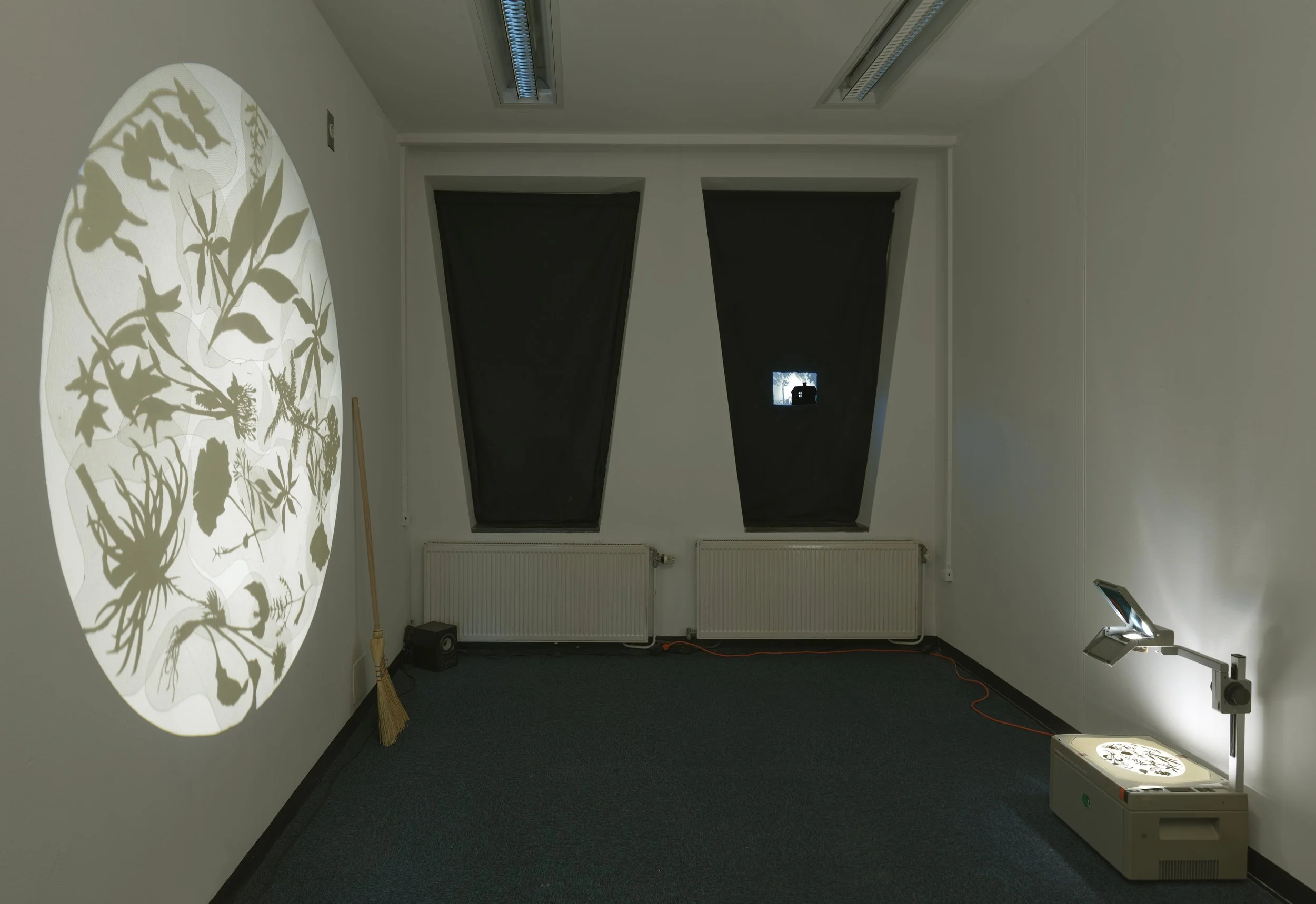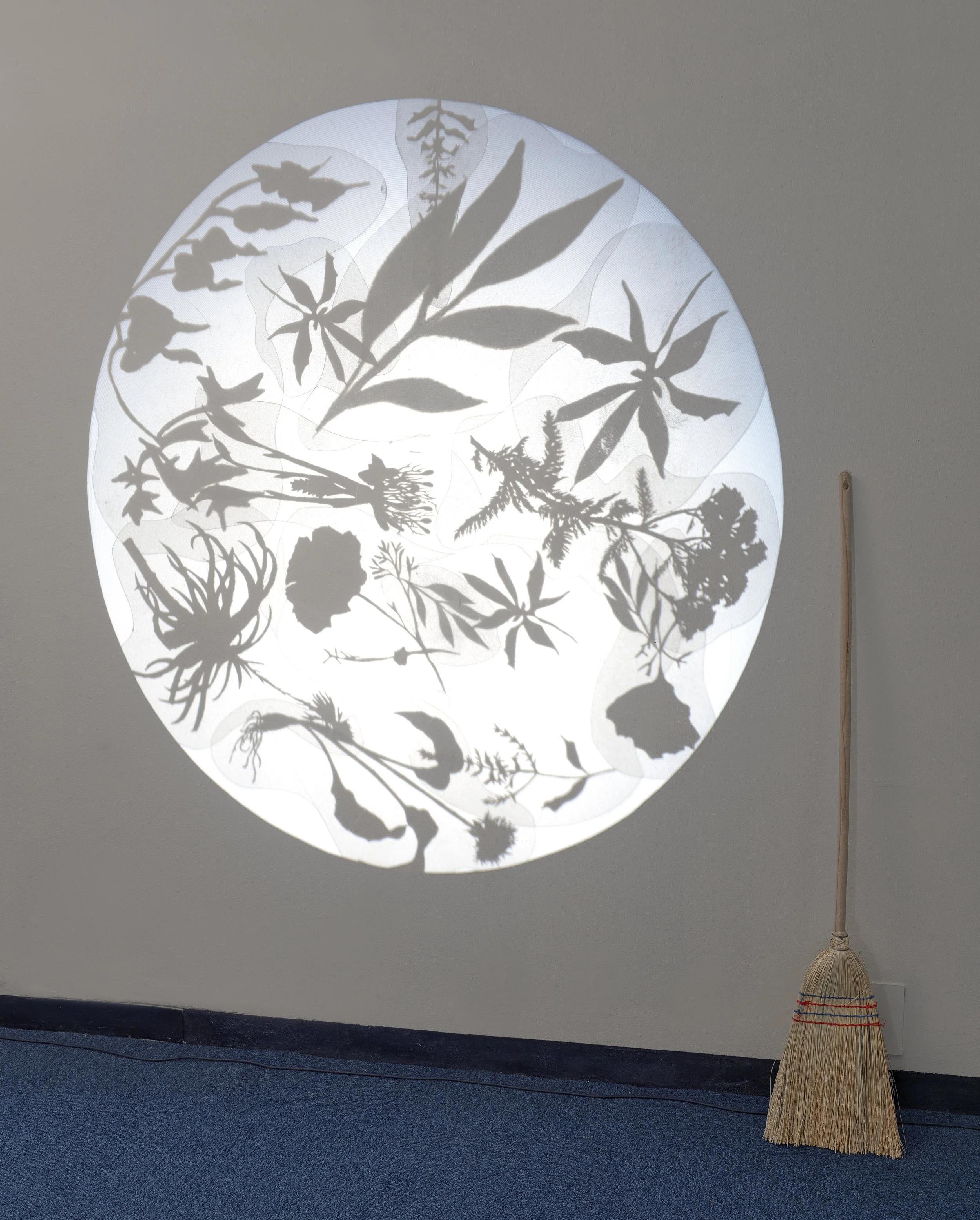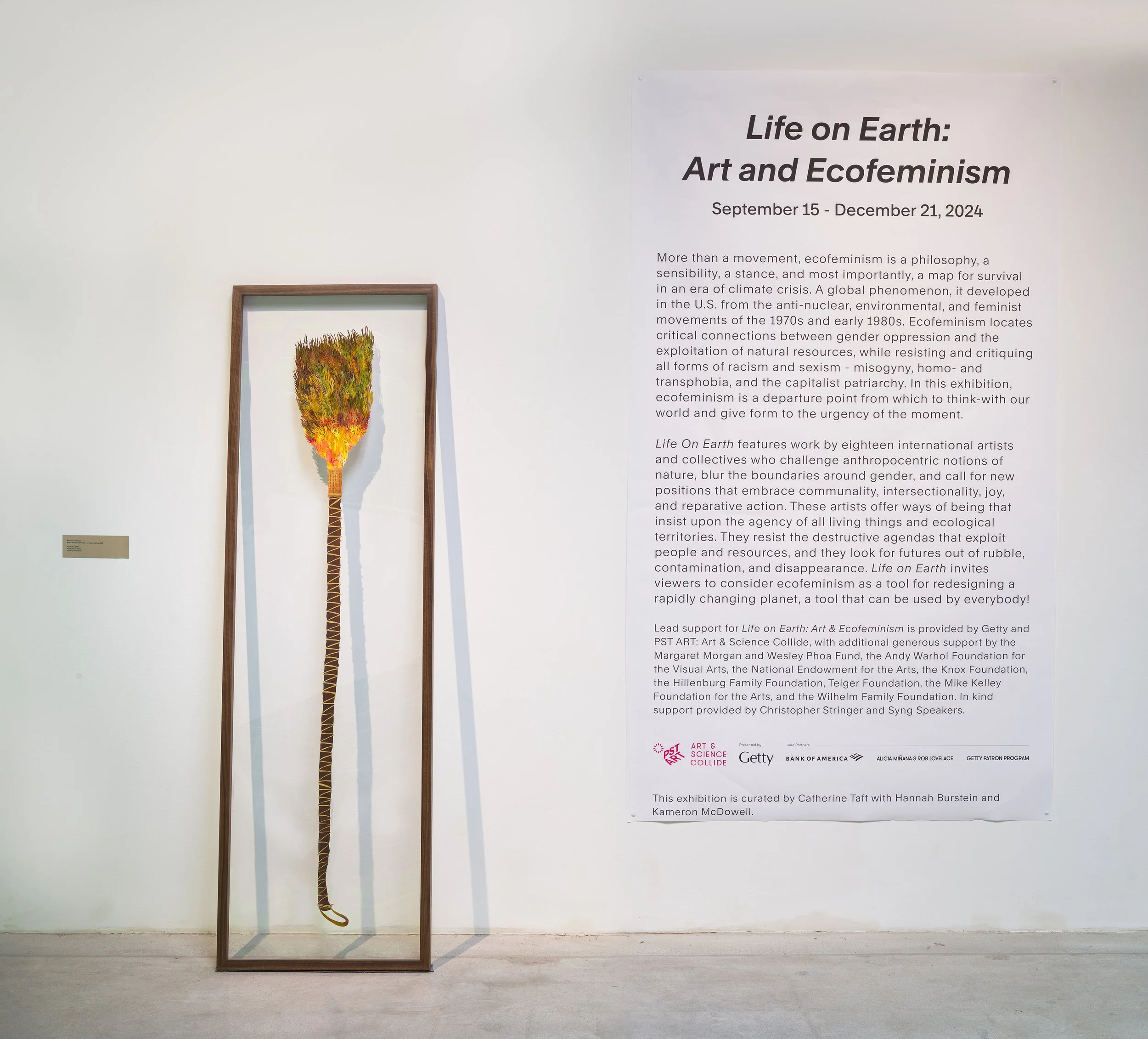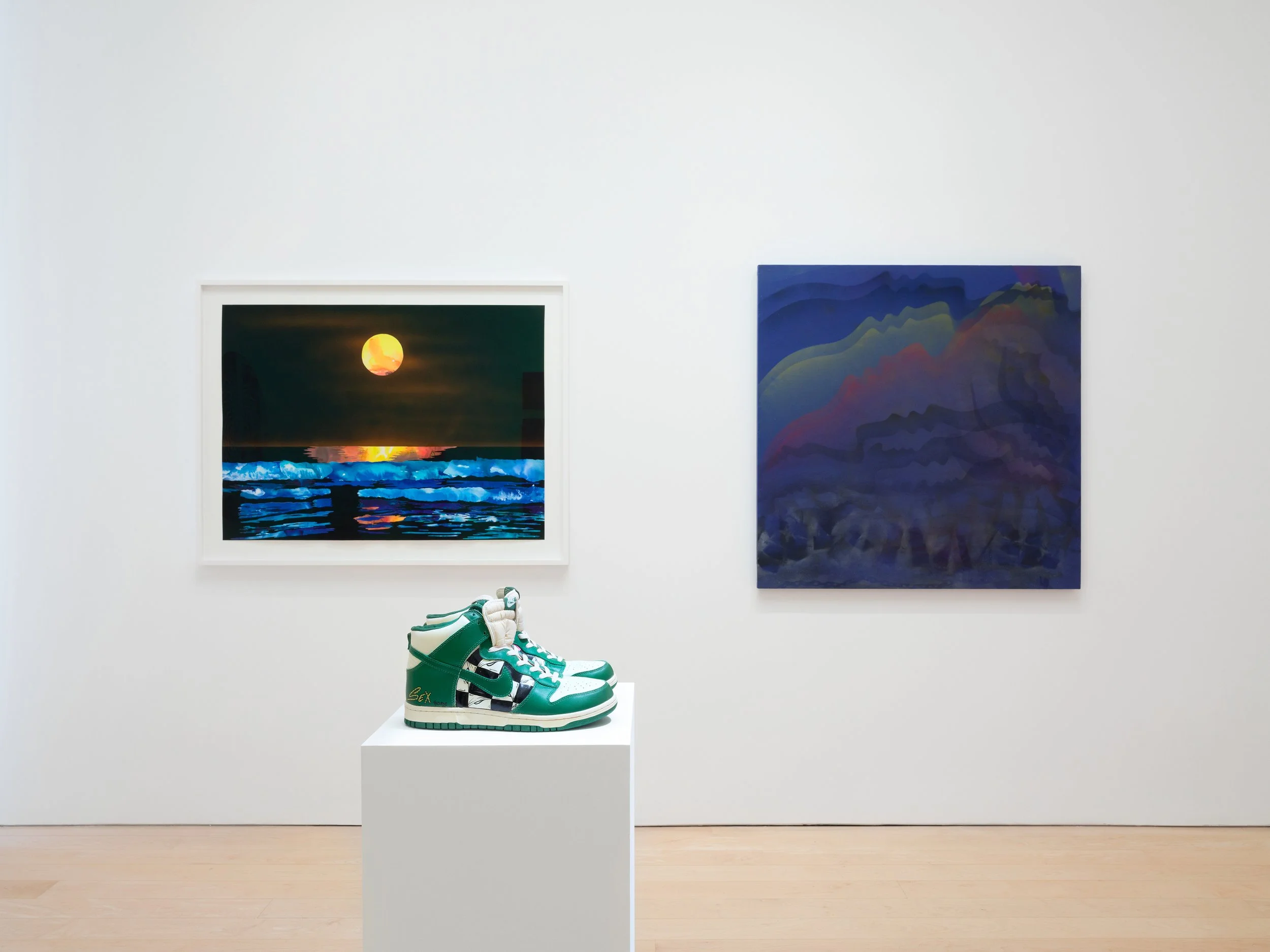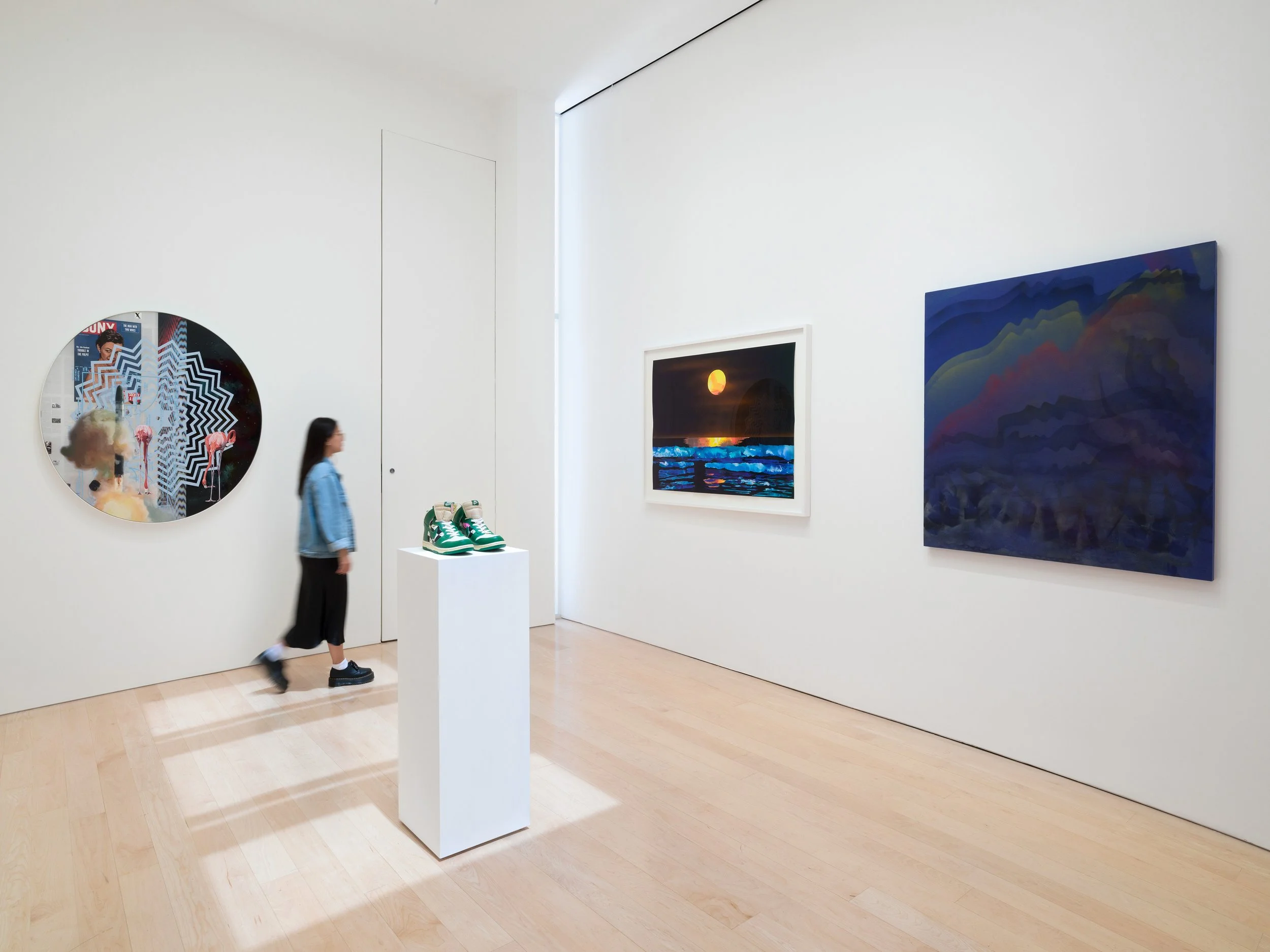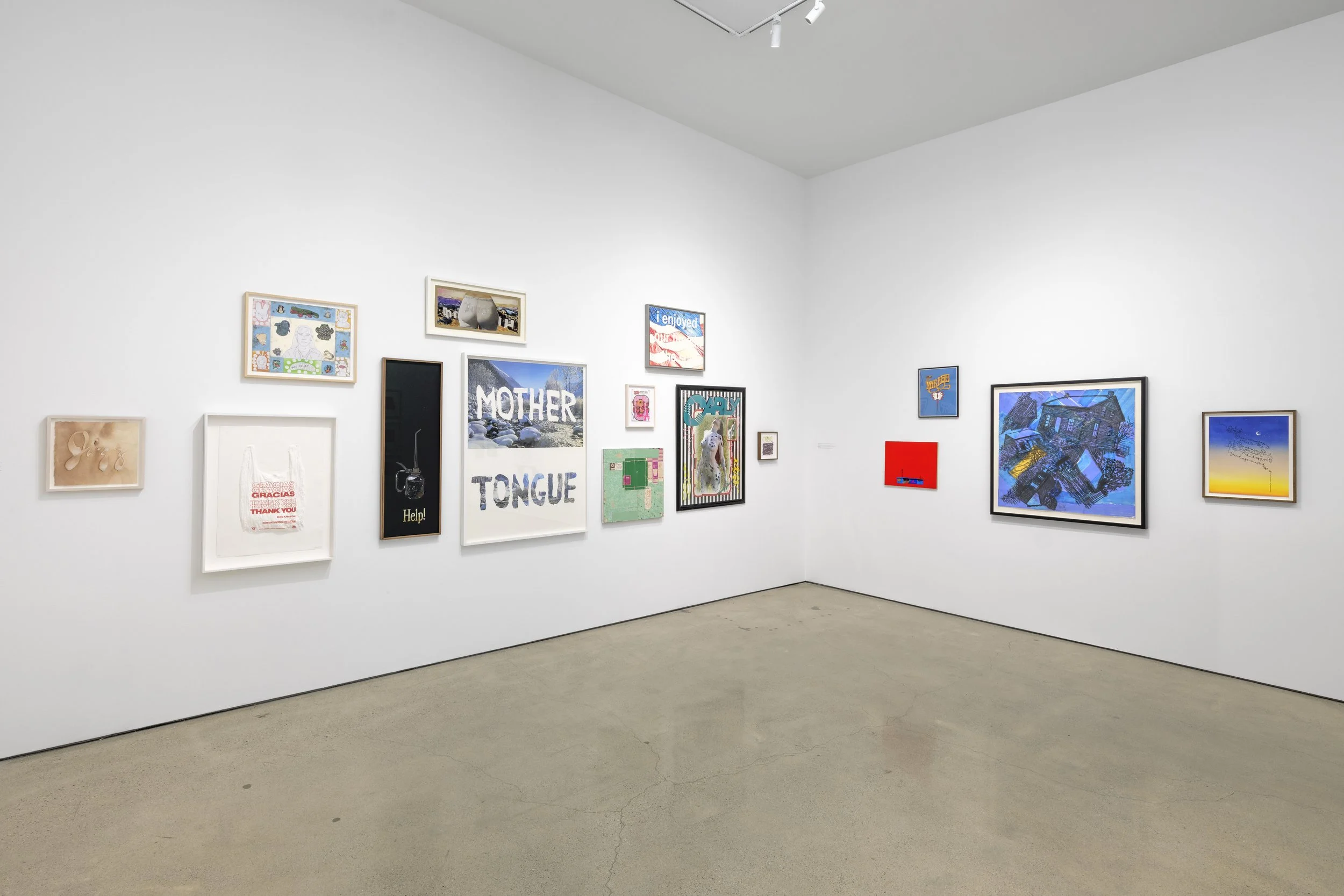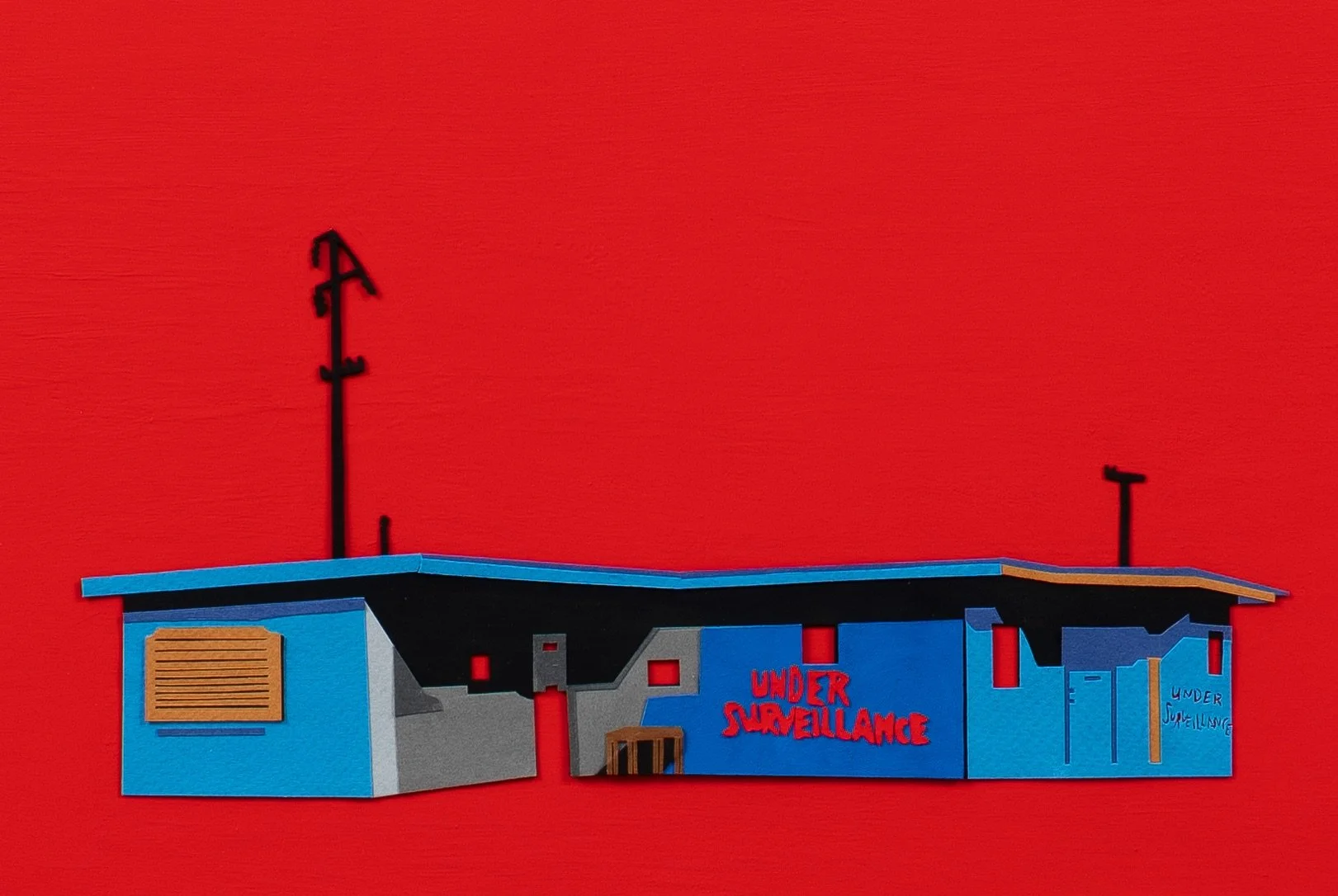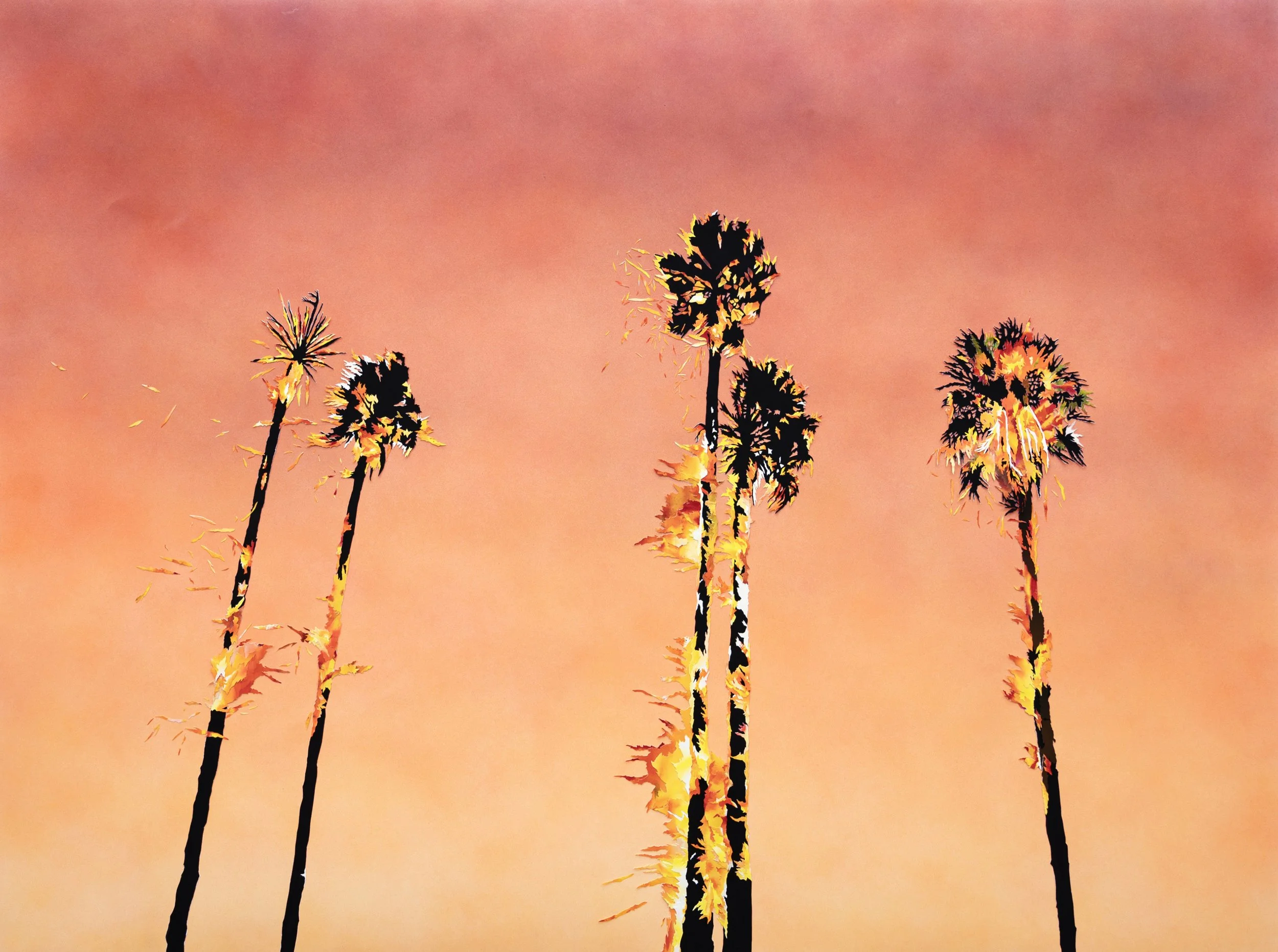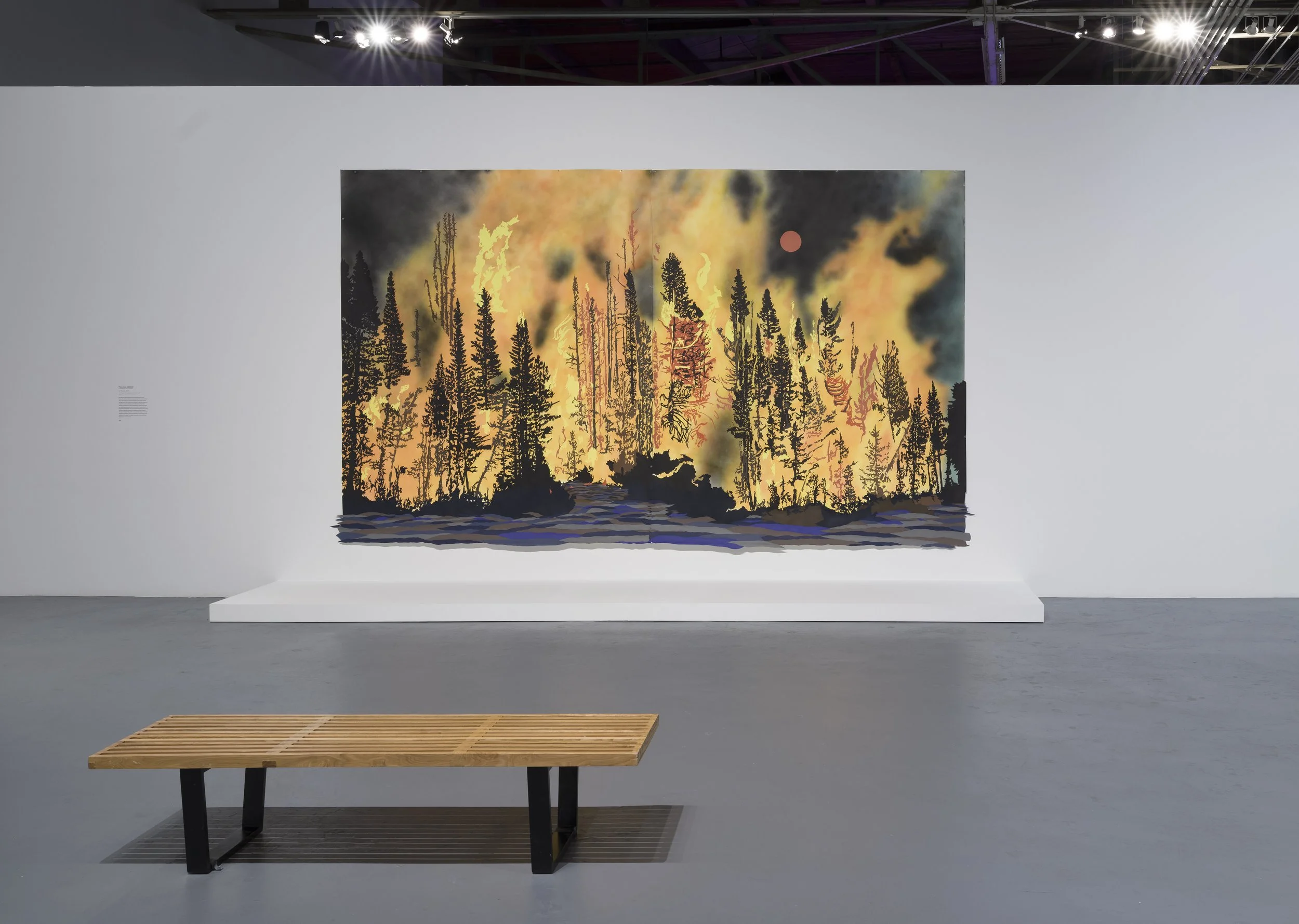Solo & COLLABORATIVE Exhibitions
FRANCESCA GABBIANI & eddie ruscha
the messengers
wilding cran GALLERY, LOS ANGELES
march 8 – april 5, 2025
Wilding Cran is pleased to present The Messengers, an exhibition of new paintings by Los Angeles-based artists Francesca Gabbiani and Eddie Ruscha, the inaugural show in our new Melrose Hill location.
Through their collaborative exchange, Gabbiani and Ruscha channel shared visions of ecological hope and healing to reflect upon the restorative cycles of the natural world. The vibrant series of works on paper combine painting and collage with soft, fluid forms and hard edges to embrace interconnection as a transcendent mode of survival. While Ruscha’s airbrush techniques produce smooth, ethereal forms, Gabbiani’s hand-painted paper collages add depth and texture, pulling the viewer into a pulsing landscape of fusion and duality.
Across the exhibition, Gabbiani’s collages of various cacti and their blossoms vibrate within Ruscha’s vivid psychedelic abstractions. The material use of paper echoes the delicate nature of each subject, while vibrant waves of radiating color allude to the unspoken presence of a deep spiritual power. Within Swelter, the jagged stalk of a flower rises through swirling hues of red and orange. The saturation gradually fades into an ethereal mist, framing two blossoms in a halo of light. The encircling beams of energy seem to emanate from the plant itself, as though it has been caught within the process of transformation. Whether withering or blossoming, the aura of each piece alludes to the sacred role of life cycles, reflecting upon the reciprocal forces of birth and death.
By inviting the viewer into a space of intuitive knowledge and spiritual resonance, The Messengers explores the resilient adaptability of plants and the ways in which they can reinform notions of transcendence and survival. The largest piece in the show, Psyacti 6, centers a blooming agave plant. As an allegory of endurance in the face of adversity, the agave blooms just before it dies -- a final act which simultaneously imparts the symbolic beauty of life’s impermanence, while functioning as an evolutionary means of seed dispersal, bringing new life through death.
Amidst the upheaval of shifting landscapes and climate disaster, the regenerative nature of life on Earth continues, reminding us that visions of destruction bring with them an organic sequence of rebirth. Within The Messengers, Francesca Gabbiani and Eddie Ruscha impart their mutual reverence for the mystical teachings embedded within the Southern California landscape. By honoring those who have grown to adapt under harsh conditions, the exhibition summons the ancient wisdom of natural forces which call to us, offering themselves as sacred beacons of strength, healing, and harmony.
FRANCESCA GABBIANI
BAERT GALLERY, LOS ANGELES
APRIL 6 – MAY 11, 2024
Baert Gallery is pleased to present Francesca Gabbiani's second exhibition with the gallery on view from April 6 to May 11, 2024. In Francesca Gabbiani’s intricately hand-cut paper collages, the cactus serves as a metaphor for resilience, endurance, and adaptation in an age of impending ecological challenges. Her carefully constructed works confront the beauty and terror of destruction reflecting the increasingly arid and life altering conditions of a changing climate in Southern California, where she now lives and works.
The protracted process of carving thorny spines and overlaying them to create depth and shadow extends beyond the experimental framework of stick-and-paste without compromising spontaneity. In this sense, Gabbiani is absorbed in layers of time, mirroring the cacti’s own slow growth and long lifespan to underscore a humanitarian need to carry forward the vast memories ingrained within the natural world.
The addition of salt to Gabbiani’s considered application of acrylic, watercolour and gouache paints makes the very act of depicting her desert flora a brutal one, gesturing towards the intensity of survival in contemporary life where water seems more precious every day. Her scenes are entirely unpeopled yet there’s a sense that these are, indeed, portraits. In an ongoing series of paintings titled ‘The Survivors’, cactus paddles begin to take the form of faces crowding towards the centre of the frame, coarse stems bowed in quiet communion. The compositional treatment of these forms, at once bodily and architectural, renders them solitary relics against looming sinister skies. A degenerative world in which nature and urbanisation collide in their innately anarchic states.
The artist’s thermal, Lynchian-washed landscapes, as in ‘Pink pink pink pink... Pink moon’ are hauntingly beautiful yet surreally desolate, indicating a broader preoccupation with dystopian themes of environmental degradation and societal collapse. All the while, her pieces seem at the same time to hold a sense of quiet beauty, as if there will always be some sort of beauty that survives. Drawing inspiration from literary figures like Donna Haraway and Octavia Butler as well as the westerns of Sam Peckinpah, Gabbiani's work delves into the eerie intersection of science fiction and societal critique, inviting viewers to confront the complexities of our modern world and the implications of our collective choices.
MUTATIONS
WILDING CRAN GALLERY, LOS ANGELES
june 29 – july 29, 2023
Wilding Cran Gallery is pleased to present Mutations, a solo exhibition of Francesca Gabbiani's material explorations of Southern California and the vulnerable narrative of paradise consumed.
Drawing inspiration from her experience living in Los Angeles, Francesca Gabbiani has been captivated by the phenomena and mythology of wildfires, returning to them over and over in an effort to dissect their psychological impact upon our social, environmental, and emotional landscapes. Towing the fine line between enchantment and trepidation, Gabbiani's intricate, labor-intensive collages evoke the fragility of the paper medium and the artist's devotional attention to beauty, while addressing the pervasive anxiety of climate disaster.
Throughout the exhibition, the image of the palm tree stands out as an icon of Gabbiani's oeuvre. Despite the fact that most palm tree species are non-native to Southern California, their historic importation into the region led to the mythic construction of a new Eden on the Pacific, a sheltered dreamscape of leisure and endless summer. Within Hot Panorama II, 2022, two palms stand as beacons, aglow in flames against a backdrop of billowing smoke and ash. Despite the enticing hues of orange, yellow, red, green, and hot white, the scene captures a precarious moment, granting the viewer time to embrace the allure - and fear - of the unknown.
In an effort to shatter the artifice of man-made paradise, Gabbiani uses markers such as chain link fences, telephone poles, burnt-out cars, and swimming pools to point to the synergistic relationship between the industrial and natural worlds. Amidst the delicately layered works on paper, a short film titled Sea of Fire screens within the gallery space, granting movement and sound to the artist's story. Opening upon a theatrical stage, a cherubic Lucifer peeks from behind red curtains, beckoning us into the flames. Breaching the gap between inferno and seascape, the film follows the journey of a marionette spider, ushering the viewer through a horrific blaze of obstacles to the fixed horizon line and ebbing tides of the Pacific Ocean.
By granting subjectivity to the life-sustaining realities of our planet, Francesca Gabbiani asks us not to look away in fear of what we cannot control. Despite decay and destruction, Mutations reminds us that wildfire is not an illicit attack, but a call to empathize and communicate with nature. For thousands of years, leading up to the institution of fire suppression laws, controlled fire was used to purify deadened landscape, fertilizing soil for new life. It is through this lens that blazing palms, ashen skies, and phosphorescent seas challenge us to reimagine our role in the shifting landscape of the earth and its inhabitants.
HOT PANORAMAS
CEDRIC BARDAWIL GALLERY, LONDON
APRIL 6 – MAY 20, 2023


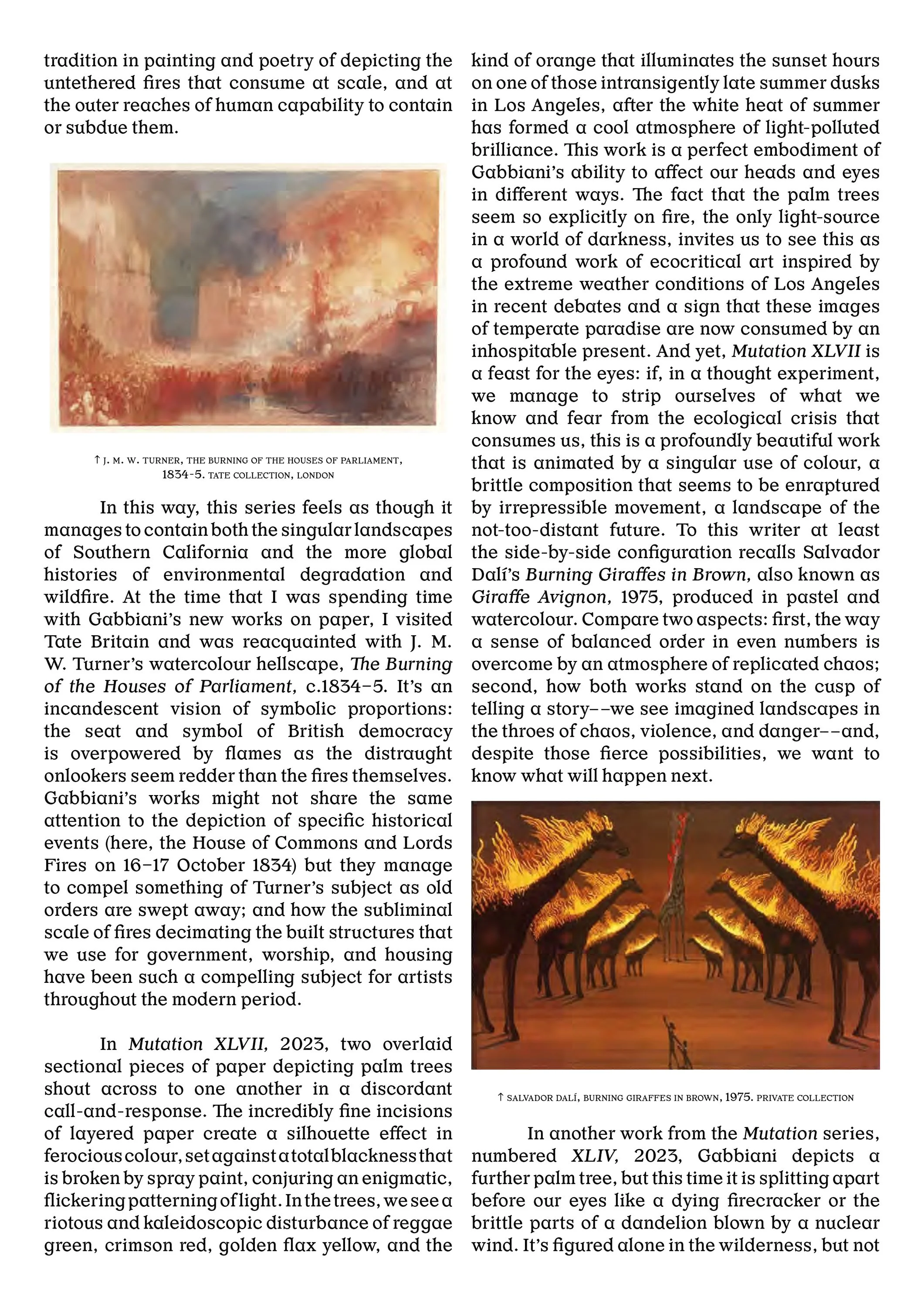


years after
mixografia, los angeles
September 10 – october 8, 2022
Mixografia is pleased to announce Francesca Gabbiani: Years After, new editions by Francesca Gabbiani. This will be the first exhibition at Mixografía for this Los Angeles based artist. Gabbiani’s editions are the latest in a body of work that gives viewers a humane perspective on life within natural urban landscapes. Gabbiani chooses places that often collect urban debris in a way that echoes the presence of its surrounding population. The exhibition includes monotype editions produced in three base colors with unique placements of highlighting color on each print.
The artist’s technique of using tiny cutout paper forms to create three dimensional layered collages sets the stage for a perfect collaboration between Gabbiani and the bespoke printing processes at Mixografia, with their attention to texture and contrast. The meticulously-carved paper pieces tell a story of “non-places” that we often ignore. These neglected plots of the “in-between”, unexploited by our capitalist society, are transformed into new havens for the unwanted. Collections of the forgotten become the new subject and birth of an entirely new scene, rich with contrast and littered with whispers of human existence. Each print in this edition is made in a similar way; however, the tiny colorful marks, which are now fused to the print, are actually cut out pieces of paper that have been added to the press before printing on in-house handmade paper.
Original works of art from the artist’s private collection as well as a continuous screening of her film, Sea of Fire, will be on view concurrently with the editions. These works reveal that Gabbiani is fascinated with man-made materials that either look like they are from nature or have been literally infused with nature over time. Her subjects consisting of dramatic landscapes, interiors, and architecture, are based on historic movie sets as well as her own chosen seedy Los Angeles surroundings.
Fire season has become an extremely powerful force of destruction in many parts of California and Gabbiani’s close encounter with these fires impacted her practice profoundly. Walking through burned ruins of mid century architecture, reduced to abstract forms, she experienced the same kind of feelings she has towards abandoned places. Looking at such experiences in a removed way is her talent, and seeing them as an object helps her work in a detached mental state. These manufactured forms have been rendered organic by the incredible forces of nature and turned into something else entirely. When finding these ambiguous areas of urban ruin, she returns time after time to sit, ponder, and place these forms in a new abstract paradigm.
vague terrains & urban fuckups
gavlak gallery, los angeles
april 13 – june 9, 2018
Gavlak is pleased to present “Vague Terrains/ Urban Fuckups”, an exhibition of new work by Los Angeles based artist, Francesca Gabbiani. This is the artist’s first solo presentation with the gallery. Non-place, a book by French anthropologist Marc Augé, explored spaces of transience where individuals are anonymous—airport waiting rooms, hotel lobbies, railway stations. Francesca Gabbiani’s beautifully crafted works have recently focused on a different and special kind of space, of wilderness that one finds in today’s urban texture, in abandoned grounds and unattended interstices of the city. The meticulously carved paper pieces by Gabbiani tell a story of another set of non-places that we often ignore in our day to day urban experience. These are littered, empty lots on which brambles and weeds flourish, suffocating all that is underneath them.
In her work we witness the growth of harsh vegetation, of vegetal species that have adapted to a hostile environment, negotiating their survival with cement and depleted topsoil, in a no-man’s-land that is neither nature nor metropolis. Their effort is anarchic; I would say vegetal-violent. What is most intriguing in the work of Gabbiani is that these plots hold enough significance for her to be observed and reproduced as “real places”, with an intrinsic value. And here is where beauty and the beauty of her work speaks to this discovery of unlikely relevance. Referred to as landscapes, they are in fact descriptions of land—a very particular kind of land that either declares its extreme poverty or its (as of yet) oblivion from developers and rampant capitalism.
Gabbiani’s works are labors of love, made painstakingly with a cutter and archival coloured papers. The fact that she spends months to years on each piece (working from a snapshot she takes) indicates more than a sociological interest on the vagaries of “culture” being reclaimed by “nature”. This time and attention models an admiration for the resilience of a primary world that slowly manages to survive in the most inhospitable surroundings against most odds. I sense empathy for these abandoned lots, for the lives they support and the quiet, invisible will by which they persist. Not unlike her earlier work of tree-houses: those semi-abandoned traces of human symbiosis with nature today have morphed into visually compelling depictions of derelict spaces. It is the expansion of her work, demonstrating a steady broadening and deepening of her vision, which gives us as viewers a humane and intense perspective on nature, the city, and the struggle for survival of that which we ignore."
- Paolo Colombo, Curator (Athens, Greece 2018)
Select Group Exhibitions
CACTUS
NOUVEAU MUSÉE NATIONAL DE MONACO
VILLA SAUBER, MONACO
JULY 6, 2025 – jANUARY 11, 2026
Simple forms, fractal figures, muted, dull or vibrant colours, prickly, downy, bristly or waxy sheaths, fleshy, velvety organs, extravagant architectures – cacti and succulents have been a source of fascination for centuries. The Nouveau Musée National de Monaco, in collaboration with the Musée YVES SAINT LAURENT Marrakech, which initiated the project in 2024, is today dedicating an exhibition to them, seen from both a botanical and artistic perspective.
Native to the ‘torrid zone’ of our planet and indicators of an arid climate, cacti are ideal subjects through which to understand the gradual spread of tropical flora in the West, carried by expeditions, explorers, and the horticultural boom of the 19th century. With their outlandish forms, they challenge our conception of plant life, were quickly reproduced in a variety of botanical publications and entered the collections of prestigious gardens. Though deceptively easy to cultivate, these plants are regularly collected and have given rise to remarkable gardens across the planet, from California to the Canaries, via the Riviera.
The unique aesthetic of cacti engaged the attention of many artists, particularly in the early 20th century, and especially during the interwar period. Their sometimes unusual originality made cacti and other succulents suggestive and inspiring motifs for architects, photographers, designers, artists, creators and filmmakers, who filled their visual worlds with their iconic forms. Few plant families have inspired so many artistic interpretations. This exhibition offers a broad overview, bringing together works as varied as an Eisenstein film, a Gufram coat stand, and a drawing created by David Hockney on an iPad! More than 200 works are brought together for the occasion: botanical treasures, archives, paintings, drawings, sculptures, photographs, installations, film extracts and design objects…
Shifting seamlessly from scientific rigour to an artificial – sometimes even strange or unsettling – aesthetic, the exhibition escapes the confines of the museum’s interior, spilling out into the gardens of the Villa Sauber, transformed for the occasion into a spectacular cactus garden with the help of the Exotic Garden of Monaco.
Artists: Kaïs Aïouch & Chahine Fellahi, Ghada Amer, Ziad Antar, Aurel Bauh, Max Beckmann, Katinka Bock, Bernard Boutet de Monvel, Constantin Brancusi, Brassaï, Maurizio Cattelan & Pierpaolo Ferrari, Philippe Chancel, Julian Charrière, Ali Cherri, Étienne Clerissi, Barbara Crane, Martin Creed, Léon Diguet, Robert Doisneau, Guido Drocco & Franco Mello avec Paul Smith, Latifa Echakhch, Sergueï Eisenstein, Ger van Elk, Emeric Feher, Alain Fleischer, Henri Foucault, Jean-François Fourtou, Michel François, Francesca Gabbiani & Eddie Ruscha, Maurizio Galante & Tal Lancman, Flor Garduño, Chris Garofalo, Lina Ghotmeh, Domenico Gnoli, Julio González, Florence Henri, Nathanaëlle Herbelin, David Hockney, Larry Jordan, Florentine et Alexandre Lamarche-Ovize, René Lalique, Romain Laprade, Fernand Léger, Jochen Lempert, Eli Lotar, Man Ray, Hilton McConnico, Mathurin Méheut, Cristina de Middel, Richard Laurence Misrach, Serge Mouille, Stéphane Passet, Mihcelangelo Pistoletto, Bernard Plossu, Albert Renger-Patzsch, Pierre-Joseph Redouté, Ed Ruscha, Yann Sérandour, Shimabuku, Louis de Sigaldi, Philippe Starck, Simon Starling, Johannes Steidl, André Steiner, Wolfgang Tillmans, Henri Tracol, Oriol Vilanova, Yannick Vu, Ossip Zadkine, Ding Zhang, Willy Zielke…
life on earth: art & ecofeminism (traveling)
west den haag, the hague, netherlands
february 28 – july 27, 2025
THE BRICK, LOS ANGELES
September 15 – December 21, 2024
Life on Earth: Art & Ecofeminism is a group exhibition featuring works by Alliance of the Southern Triangle (A.S.T.), Alicia Barney Caldas, Meech Boakye, Carolina Caycedo, Francesca Gabbiani, Institute of Queer Ecology (IQECO), Kite, Leslie Labowitz Starus, Maria Maea, Otobong Nkanga, yétúndé olagbaju, Alicia Piller, Aviva Rahmani, Tabita Rezaire, Yo-E Ryou, Emilija Skarnulyte, Natalia (Nika) Sorzano & Papaya Kuir, and A.L. Steiner.
The exhibition is inspired by four decades of ecofeminist thought and practice in art, offering new perspectives on gender and ecology. Ecofeminism is a theoretical and activist movement that draws critical connections between gender, oppression, and the exploitation of natural resources. Emerging in the late 1970s through environmental protests, anti-nuclear initiatives, and feminist activism, ecofeminism addresses the oppression of both nature and women. It also confronts racism, homophobia, and capitalist patriarchy. Artists embrace these ideas, creating innovative and often site-specific works that expose and interrogate these systemic issues.
Life on Earth uses ecofeminism as a starting point, bringing together an international group of artists and collectives. They present new methodologies for reconsidering our natural environment in the 21st century. The works challenge anthropocentric ideas about gender and ecology and advocate for innovative approaches rooted in collectivity, myth-making, joy, and restorative actions.
The exhibition and its accompanying event program address themes such as social ecology, the commons, activism, witchcraft, hydrofeminism, plant knowledge, science fiction, and speculative futures. This exhibition is curated by Catherine Taft, deputy director of The Brick in Los Angeles.
art for a safe and healthy california
gagosian GALLERY, beverly hills, california
July 18 – August 30, 2024
Gagosian is pleased to announce Art for a Safe and Healthy California, a benefit exhibition presented in Beverly Hills by renowned actor and activist Jane Fonda together with the gallery.
Thanks to the Campaign for a Safe and Healthy California and its partnership with the arts community, California Independent Petroleum Association announced this month that it would withdraw a referendum on California’s landmark law (SB 1137) to protect neighborhoods from toxic oil drilling from the November ballot. As a result of this early win, the Campaign has become a general-purpose committee that aims to protect frontline communities from Big Oil’s next attempts at pollution and destruction for profit. Art for a Safe and Healthy California is an exhibition designed to provide valuable support for this crucial initiative.
The highly successful benefit launched on April 9 with an extensively reported-on event at the gallery’s Beverly Hills location that raised more than $14 million for the Campaign. Gagosian is grateful to the artists who participated in the project at this critical first stage, including Ed Ruscha, Charles Gaines, Mark Grotjahn, Jonas Wood, Sarah Cain, Karon Davis, Jules de Balincourt, Olafur Eliasson, Francesca Gabbiani, Marilyn Minter, Catherine Opie, Christina Quarles, Nathaniel Mary Quinn, Kenny Scharf, and Joey Terrill. In May, a selection of works by these and other artists was auctioned at Christie’s during their marquee sale week. A second set of works—by Frank Gehry, Nan Goldin, M (aka Michael Chow), Hank Willis Thomas, and others—is now being presented for sale, also at Gagosian Beverly Hills, in an exhibition that opens on July 18 and is on view through August 30.
“I am thrilled to be able to use my love of art to propel the fight against climate injustice while simultaneously uplifting the work of these talented and generous artists,” said Fonda. “I am so fortunate to have Larry Gagosian and his LA team by my side as we continue to pursue a safer and healthier California.” Larry Gagosian remarked, “Jane has been a great friend for over forty years, and an icon of the American cultural landscape since the 1960s. I have always admired her activism, and when she brought this urgent David vs. Goliath cause to my attention, I didn’t hesitate. It has been an honor to partner with her on this crucial issue impacting my home state of California—from the launch event in April to the upcoming exhibition to raise funds to support this effort into the future. I am incredibly grateful for the artists’ generosity in helping us ensure a safe and healthy California for generations to come.”
Hollywood dream bubble
the hole, los angeles
april 27 – june 15, 2024
The Hole is pleased to present HOLLYWOOD DREAM BUBBLE: Ed Ruscha’s Influence in Los Angeles and Beyond, a group show by guest curatorial duo Jessica Gallucci and artist Dani Tull. Ed Ruscha has occupied many roles in the broad cultural consciousness—foil to the New York-based Ab-Ex movement, a member of Ferus Gallery’s “cool school”, standard-bearer for Southern California and renderer of funny and oracular words in his Boy Scout Utility Modern font—but among artists, particularly in Los Angeles, he is known for his steadfast support of the scene. He shows up at openings: he collaborates, he collects and he donates. Hamilton Press, the Venice fine art printing company he co-founded, invites emerging artists to produce editions.
With more than seventy artists, this is not a “tightly curated” exhibition: neither could it possibly be a comprehensive one. HOLLYWOOD DREAM BUBBLE is just a piece of the discourse around the great artist’s reach and a celebration of his impact among American artists across generations. Two and a half miles away from Ruscha’s LACMA retrospective, the conversation continues.
Artists: Adam Stamp, Aaron Curry, Adam Rabinowitz, Alfred Steiner, Allen Ruppersberg, Amir Zaki, Analia Saban, Bart Exposito, Benjamin Weissman, Bettina Hubby, Brice Bischoff, Carly Jean Andrews, Catherine Opie, Chaz Bojorquez, Chris Johanson, Dan Attoe, Dani Tull, Daniel Hawkins, Dave Muller, Deborah Kass, Dennis Hopper, Doug Crocco, Eddie Ruscha, Ellen Jong, Eric Yahnker, Frances Stark, Francesca Gabbiani, Friedrich Kunath, Gary Simmons, Greg Colson, Hamilton Press, Harland Miller, Jaime Muñoz, Jason Mason, Jason Rhoades, Jeffrey Vallance, Jennifer West, Jeremy Shockley, Jim Shaw, Kelly Wall, Kenny Scharf, Kim Gordon, Kristopher Raos, Lari Pittman, Lisa Anne Auerbach, Mark Hagen, Matt Murphy, Michael Bevilacqua, Michael Decker, Michael Ho, Michael Lombardo, Mike Kelley, Mitchell Syrop, Mungo Thomson, Nick Taggart, Nicolas Shake, Norm Laich, Pae White, Pentti Monkkonen, Pippa Garner, Raymond Pettibon, Renée Petropoulos, Ricci Albenda, Rives Granade, Rob Pruitt, Roni Horn, Ry Rocklen, Sam Durant, Senon Williams, Wallace Berman, Wendy White and Zoe Crosher.
the gaia hypothesis: palm trees also die
The elemental, palm springs, california
march 2 – may 25, 2024
Palm Trees Also Die is the second chapter in THE ELEMENTAL's inaugural cycle of exhibitions. The aim of this cycle is to develop the visual, sensitive and performative writing of a collective, imaginary novel dedicated to the Gaia Hypothesis. According to the hypothesis formulated by James Lovelock and Lynn Margulis at the dawn of the 70s, Gaia is the name given to the Earth defined as a living, self-regulating super-organism that maintains a positive balance for life. With the Gaia Hypothesis, we are invited to reconsider the ways we inherited from Modernity of understanding and thinking about the environment. What's more, we are called upon to think differently about living things, to understand the subtle interdependencies that link all their components. The Earth is not the backdrop to our actions, but an actor in human history in its own right, never separate from us, whatever the Moderns may think. Gaia, as a living organism, reacts to our actions in a set of "feedback loops", as climate change and environmental disasters perfectly illustrate. We are linked to the Earth and we must understand her fragility, which is in reality, not hers but ours.
Francesca Gabbiani's "Hot Panorama V" (2023), a subtle combination of painting, collage and paper-cutting techniques, invites us to take in the sight of burning palms, but here, perhaps, we should perceive a regenerative fire.
Artists: Rachid Bouhamidi, Bill Leigh Brewer, Charlotte Charbonnel, Zoe Crosher, Edward S. Curtis, Lélia Demoisy, DISNOVATION, Sara Favriau, Diego Ascencio Fuentes, Jeff Frost, Francesca Gabbiani, Lance Gerber, Barbara Gothard, Mehdi-Georges Lahlou, Vincent Lamouroux, Reine Paradis, Ed Ruscha, Chris Sanchez, Robert Smithson, Katrin Ströbel, Rebecca Webb. Curated by Christopher Yggdre.
lonesome crowded west
the geffen contemporary at moca, los angeles
april 24, 2022 – february 12, 2023
The historian Clyde Milner has written that the American West is “an idea that became a place.” Indeed, the “West” is both a reality and a cultural concept that has been used to optimistic and opportunistic ends; it has stood as an allegory for rugged American individualism, signaling possibility and expansion, but also for the stark reality of settler-colonial exploitation. Given this thorny legacy, what should a picture of the West look like today? The artists in this exhibition respond to this question from a multiplicity of perspectives, tracing the contours of the American West through individual stories and collective histories, and through reflection on climate and the tension between the built and natural environment. Speaking with a plurality of voices, they ask not so much what the West means, but rather what it is, and what it can mean to be in.
Drawing down the moon
the hammer museum, los angeles
june 19 – september 11, 2022
The Hammer Museum at UCLA presents Drawing Down the Moon, an exhibition that surveys the iconography of the moon and is drawn exclusively from institutional collections and artist studios of Los Angeles. Well-known works of art such as Caspar David Friederich’s A Walk at Dusk (1830-1835) are displayed alongside unexpected objects like an 18th-century moon-shaped rabbit in ivory from Japan. Organized by Allegra Pesenti, Drawing Down the Moon will be on view from June 19 to September 11, 2022.
The moon has served the most elemental and vital functions such as providing light and measuring time, and it has sourced the more intangible and spiritual realm of gods and myths. Throughout the world, cultures have associated their own symbols and traditions with the moon, and each has invoked it in its own manner. Drawing Down the Moon leads the visitor through a panoply of objects dating from antiquity to the present. Objects from the Hammer’s Grunwald Center Collection and Hammer Contemporary Collection are complemented by loans from The Broad, Caltech Library, The Claremont Colleges Library, Getty Research Institute, J. Paul Getty Museum, LACMA, Norton Simon Museum, The Philosophical Research Society Library, and UCLA Library.
“This exhibition traces humanity’s long fascination with the moon,” said Hammer Museum director Ann Philbin. “Allegra Pesenti has assembled a sublime array of objects from the collections of the Hammer and other museums and libraries that capture the moon’s ineffable magic. From etchings and drawings to monumental paintings and rare editions illustrating the earliest scientific discoveries of the moon, the variety of objects and perspectives creates a truly compelling exhibition.”
Artist Francesca Gabbiani will lead a walk-through of the exhibition on August 28th at 3pm.
